Reading
Log For 2003
THE
BOOK
OF FIVE RINGS
A New Translation from the Japanese by Thomas
Cleary (1993)
including
The Book of Family Traditions on the Art of War by Yagyu
Munenori
Hardcover
Barnes & Noble Books, New York
2002-12-30 to 2003-01-02
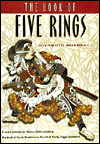
THE
BIBLE AS
HISTORY
(1956, updated 1980)
Translated from the German by William
Neil
New material translated from the German by B.
H. Rasmussen
2002-12-20 to 2003-02-06

- In general, Keller argues that archaeology supported
Biblical
stories.
Most chapters end with Rehork disputing Keller based on more recent
evidence.
- Many of the arguments made against errancy (THE
BIBLE UNEARTHED (2001), etc.) could also be make
against this
book:
A bunch of pottery sherds don’t prove anything; Monarchs use
names of
ancestors,
so you could be talking about two different guys; cities and towns may
have more than one name; etc.
- Early on, mentions that there are many towns in the Middle
East with
Biblical
names. But he also mentions that these were relatively new towns.
- 46:
That day [1929] a telegram from
Mesopotamia flashed
what was perhaps the most extraordinary message that had ever stirred
men’s
imaginations “We have found the Flood”.
The incredible discovery
at Ur made headline news in the United States and in Britain.
The Flood—that was the only
possible explanation
of this great clay deposit beneath the hill at Ur, which quite clearly
separated two epochs of settlements
In all the flood traditions which
have been mentioned, problems arise
from
mankind’s unfortunate tendency to believe what it wants to
believe
- 67: Extra-Biblical references to
“Abraham” and “Benjamites” were
thought
to support their existence. It was later discovered that these names
were
common at the time, and almost certainly did not refer to the Biblical
people.
- 72:
The part of the country which was to become the home
of the Israelite
people
was named by the Romans after Israel’s worst enemies:
Palestine comes
from
Pelishtim, as the Philistines are called in the Old Testament.
- 97: The story of Joseph and the Potiphar’s wife
is mirrored with
Egyptian
story of Anubis and his brother’s wife.
- 106: D. B. Redford has 23 reasons why story of Joseph did
not take
place
during the Hyksos period, but rather much later.
- 116: The Hittites in the Bible are definitely not the
archaeological
Hittite
Empire.
- 118: Exodus 1:8-11 says that the new Pharaoh
“knew not Joseph”
- 123: Many details from the story of Moses are shared by
that of King
Sargon,
founder of Akkad in 2360 B.C.
- 126 ftnt: The German Bible users Ried-Meer = Reed Sea and
Rotes Meer =
Red Sea. The English Bible makes no distinction. Hebrew Yam Suph = Reed
Sea.
- 127: A caravan of cattle and people can cover 45 miles in 3
days Then
why
do they wander over a few hundred square miles for 40 years!
- 140: Egyptian “Book of the Dead”
chapter 125 has deceased people make
the
confession:
I have not made any man sick
I have not made any man weep
I have not killed
I have not commanded any man to kill
I have not done harm to any man
I have not diminished the amount of the foodstuffs in the temples
I have not damaged the loaves offered to the gods
I have not stolen the loaves offered to the dead
I have not had any (illicit) sexual relations
I have not engaged in any unnatural lewdness
The consequence of this renders
it difficult for us today to
maintain
the earlier claim that the Biblical code of laws was unique. This fact
may well shake the confidence of many people. We cannot remove this
feeling
of uncertainty. On the other hand, in consequence of confirmation from
non-Biblical sources of the relevant Bible texts, Israel’s
relationship
to the cultural and historical world around it as well as to the
precepts
of its neighbors now appears to us in a much clearer light.
- 172: Despite their mention in early books of the Bible,
camels were
almost
certainly not introduced until much later.
- 182: Major Vivian Gilbert, a British army officer in World
War I writes
that a brigade major in Allenby’s army used extremely
detailed
geographical
information in I Samuel for attacking a Turkish emplacement, using the
same tactics from the Bible.
- 219: The relationship between Sheba and Solomon was
embellished. The
Awwam
temple at Marib does not date to the time of Sheba.
- 260: The deaths of Assyrians in camp before they could
attack Jerusalem
is possibly attributed to plague.
- 267: The worship of idols was commonplace during Biblical
period: A
brazen
serpent was worshipped in the Temple at Jerusalem until the time of
King
Hezekiah of Judah, abound 700 B.C.
- 284: Despite the “exile” there were
still Jews in Judah.
- 297-298: The birth story of Jesus mirrors that of Cyrus the
Great, five
centuries earlier.
- 299:
“Mene, Mene, Tekel,
Uparsin” were the words on
the wall which have
become famous. They mean: “God hath numbered thy
kingdom”. “Thou art
weighed
in the balances and art found wanting”. “Thy
kingdom is divided and
given
to the Medes and Persians” (Dan. 5:25-28)
- 299: The king who the book of Daniel calls Nebuchadnezzar
was Nabonidus.
- 310:
In view of the fact that, long before Alexander, the
Greeks had been
stretching
out their feelers in a thousand ways in the direction of Mesopotamia
and
Egypt, we can only shake our heads in amazement at Jewish ignorance of
the ways of the world. Time seems to have been standing still in the
little
theocracy and the life of its tiny religious community appears to have
been influenced only by the Torah, the Law of God.
- 312: According to legend, seventy Hebrew scribes were
locked away
separately
and tasked to translate the Torah into Greek. Because they
all
supposedly
independently came up with identical translations, it was referred to
as
the “Septuagint”, meaning “the
Seventy”.
- 328: The translation for the star “In the
East” in Matthew 2:8 is Greek
singular “En té anatolé”
but elsewhere “the East”
is translated as plural “antolai”.
This refers to the early
(heliacal)
rising, which the translators of the Authorized Version could not have
known.
- 336: The story of a chosen child exposed to danger is
attached to
Sargon
of Akkad, Moses, Cyrus the Great, Emperor Augustus, and Oedipus.
- 350: Mention of Jesus “... in Josephus must be
considered a forgery.”
- 351:
Moreover, the Evangelists linked the crucifixion of
Jesus with so many
passages from the Old Testament that it would almost be possible to
have
doubts about Jesus’ crucifixion. Can all these
terrible things
have
been imagined merely for the sake of cross references in the
Bible?
And it must not be forgotten that Jesus was by no means the first god
to
be crucified! He had been preceded by fertility gods who
suffered
and were put to death.
- 365: Joseph (Josephus the historian) was appointed
commander-in-chief
of
Galilee, captured by Vespasian’s troops in October 67.
- 367: Josephus tries to reason with the holdout Jews:
O hard hearted men, throw away your weapons, have
pity on your country
that stands on the edge of the abyss. Look round and behold
the
beauty
of all that you are ready to betray. What a city! What a
Temple!
What gifts from so many nations! Who would dare to let all of
this
be given to the flames? Is there one of you who can wish for
all
this to be no more? What more precious treasure could have
been
given
to a man to preserve—You obdurate creatures, more unfeeling
that these
very stones!
SLEEPING
WITH
EXTRA-TERRESTRIALS
The Rise Of Irrationalism And Perils Of Piety (1999)
Hardcover
Pantheon Books, New York
2002-12-30 to 2002-01-02

- 3: Confesses that she goes to a homeopath.
- 8:
I’m not oblivious to
the comfort that supernaturalism may
provide or
unimpressed by the powerful human impulse to believe; nor am I utterly
secure in my disbelief. Skepticism is an attitude, not dogma.
Pop gurus prey on existential
anxieties and thrive when our fear of
being alone and mortal in an indifferent universe is stronger than our
judgment. Argue with them. No one who demands worship,
however
covertly,
deserves respect.
- 178: The widely held pessimism about crack babies in the
1908s was
based
on scanty evidence. The long-term effects were unknown.
- 211: The Paula Jones suit against Bill Clinton involved a
lot of pop
feminist
victimization.
Her objective evidence of
discrimination—not receiving
flowers on
Secretaries
Day—was laughable.
- 217: Loving v. Virginia went to Supreme
Court in 1967. The
Lovings
had been criminally prosecuted under Virginia’s
anti-miscegenation law.
Given a suspended sentence under the condition that they leave the
state.
- 225-226:
Cyberspace is bound to change the way we reason, as
well as the way we
read, and perhaps because I can’t envision the New
Rationalism that
supposedly
awaits us, I’m already nostalgic for the Old. Hypertext will
be the
death
of argument—those tightly structured skeins of logic that
require
attentive
readers, undistracted by linkages. Interrupt an argument repeatedly,
and
you defeat it.
Peter Schrag demonstrated the
dangers of government by referendum in Paradise
Lost, a 1998 book analyzing the California
experience. Schrag
observed
that referendums became the tool of affluent whites, disinclined to
support
public services for less affluent immigrants and racial minorities.
White
voters represented about half the state’s population, but 78
percent of
the electorate, and they have been responsible for passing the forty
ballot
questions approved since 1978. The result has been what Schrag termed
the
“Mississification” of California: a dramatic
decline in public
infrastructure
and especially public schools.
To believe that society can successfully
rid itself
of religious belief, you have to regard faith as essentially voluntary,
and I suspect it is more like an instinctive reflex, a reflection of
taste
and temperament.
THE
ART OF
DECEPTION
Controlling The Human Element Of Security (2002)
Hardcover
Wiley Publishing, Indianapolis
2003-01-31 to 2003-02-16
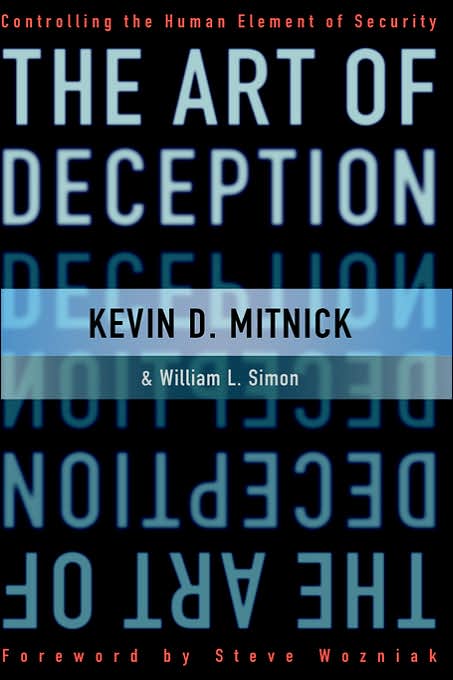
- ix: Picked up blank bus transfers from bus terminal garbage
and used a
code to punch them in order to ride for free wherever he wanted
- xii: social engineer = uses deception, influence, and
persuasion
against
businesses, usually targeting their information. vs. grifter = swindles
and cheats people out of their money.
- All requests for computer and voice mail accounts should be
written and
require signatures.
- 208: A double standard: antiviral software does not check
for spyware.
- 246: Feb. 2001 Scientific American:
Robert B. Cialdini
summarized
research on manipulation.
- 257: Recommends companies provide a copy of his book to all
employees.
JAPAN
INC.
An Introduction To Japanese Economics (The Comic
Book, 1986)
Translated from the Japanese by Betsey
Scheiner
Paperback
University of California Press, Berkeley
2003-02-15 to 2003-02-17

- The wily Tsugawa and the kindly Kudo were obviously more
symbolic than
literal. Otherwise they seemed to have delusions of grandeur, as if the
entire future of Japanese economics rested on them.
- 104-118: The yen was introduced in 1871 as ¥1 = $1.
By April 1949,
the rate was set ¥360 = $1. The reason was not known, although
it
might
be because “yen” means
“circle.” In August 1971, it moved to a
fluctuating-market
system. It temporarily floated during the “Nixon
shock.”
- 209-210: Because of the Great Depression, finance minister
Takahashi
Korekiyo
began a bond drive in 1931 to provide revive business and fund the
military.
Later, when prosperity returned, he decreased national and military
expenditures
to prevent inflation. He was killed by an angry military on 26 Feb.,
1936.
- 210 ftnt: In 1949, Joseph Dodge came to Japan form the U.S.
in order to
deal with Japanese inflation, enforcing a balanced budget known as the
“Dodge Line.”
- 254: Kudo:
“Because it’s easy
to make a
killing on the stock market rather
than
investing in equipment, U.S. companies don’t renovate their
equipment.”
- 256 ftnt: In the U.S., banking and securities are separated
under the
Glass-Steagall
Act, which arose from the lesson of the Great Depression.
- 270 ftnt: Joint operation of banks and securities companies
is
prohibited
in the U.S. and Japan, but is possible to combine securities and trust
operations in “universal banking.”
INTRODUCING
EVOLUTIONARY PSYCHOLOGY (1999)
UK: Icon Books, Duxford, Cambridge
USA: Totem Books, Lanham, Maryland
Read entirely on 2003-02-17
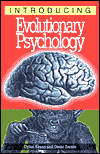
- 33: Noam Chomsky showed in the 1950s that a
general-purpose computer
learning
program could not learn a language under the same conditions as a human
child. Adult speech contains lots of errors, but no
indication of
what is correct and incorrect: ‘the poverty of
stimulus.”
- 83: Robert Trivers wrote a famous paper
“Parent-Offspring Conflict” in
1974 which argued that children want more than parents are willing to
give
because every child is twice as related to itself than to its offspring.
- 93: Children do not develop a Theory of Mind until
about 4 ½,
and
cannot comprehend that others hold beliefs different from their
own.
Illustrated in the “Sally-Ann” test.
EXTRAORDINARY
POPULAR DELUSIONS AND THE MADNESS OF CROWDS (1841)
Paperback
Wiley Investment Classics, New York
Only includes first 3 chapters: 2002-07-14 to
2002-07-16
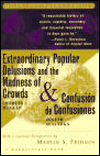
Introduction (1996)
- 2 - 3:
Mackay’s influence extends far
beyond the confines
of
the financial markets. A survey of the media yields allusions
to Extraordinary
Popular Delusions and the Madness of Crowds in
connection with
computer virus protection, the confirmation hearings of Supreme Court
Justice
Clarence Thomas, Halley’s comet, the proliferation of casino
gambling,
Teenage Mutant Ninja Turtles, and the Power Rangers.
Hardcover
MetroBooks, New York
Rest of book: 2003-02-17 to 2003-03-25
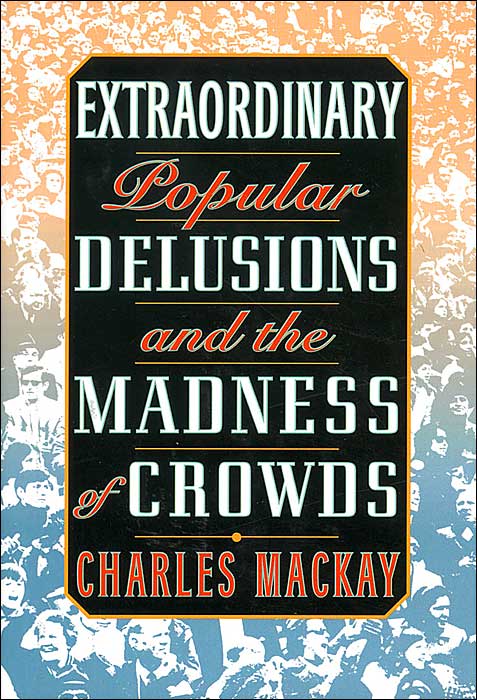
Foreword (1932)
Although there be no scientific
cure, yet, as in all primitive,
unknown
(and therefore diabolic) spells, there may be potent
incantations.
I have always thought that if, in the lamentable era of the
“New
Economics,”
culminating in 1929, even in the very presence of dizzily spiralling
prices,
we had all continuously repeated,“two
and two
still
make four,” much of the evil might
have been averted.
Similarly,
even in the general moment of gloom in which this foreword is written,
when many begin to wonder if declines will never halt, the appropriate
abracadabra may be: “They always did.”
Money Mania.—The Mississippi Scheme
- 1: The Mississippi Scheme was perpetrated on France by John
Law in
1710-1720.
- 6: The death of Louis XIV left France with a debt of 3000
millions
livres,
a revenue of 145 million, expenses of 142 millions per year, leaving
only
3 millions to pay interest upon the principal.
- 7: Informers on tax cheaters were given an incentive of 1/5
of all
fines
and confiscations.
- 10: Law make his own currency for French banks.
It did better
than
the national currency, which tended to depreciate. Originally, his
maxim
was that a banker deserved death who issued paper without the security
to back it up.
- 14: People rushed in to buy shares of Law’s
Mississippi project, which
promised 120% profit.
- 30:
Lord Stair, the English
ambassador, said, that it was now impossible
to doubt of the sincerity of Law’s conversion to the Catholic
religion;
he had established the inquisition, after having
given abundant
evidence of his faith in transubstantiation, by
turning so much
gold into paper.
- 32: By May 1720, there was twice as much paper specie as
government
coin.
- 42: Despite bringing ruin to the French economy, John Law
was a true
believer
that his system would make France the most powerful country in the
world,
and therefore only invested in France. His only asset upon
leaving
was a single diamond. “This fact alone ought to rescue his
memory from
the charge of knavery, so often and so unjustly brought against
him.”
The South-Sea Bubble
- 46: The South-Sea Bubble began when merchants took up the
British army
and navy debt in 1711 in exchange for certain privileges.
- 50: Mr. Robert Walpole was the only member of parliament to
speak out
against
the idea:
“the dangerous practice
of stock-jobbing, and would divert
the
genius
of the nation from trade and industry. It would hold out a
dangerous
lure to decoy the unwary to their ruin, by making them part with the
earnings
of their labour for a prospect of imaginary wealth. The great
principle
of the project was an evil of first-rate magnitude; it was to raise
artificially
the value of the stock, by exciting and keeping up a general
infatuation,
and by promising dividends out of funds which could never be adequate
to
the purpose.”
- 55: Descriptions of schemes were often absurd, such as for
a wheel for
perpetual motion—capital one million, but the most surreal
was “A
company
for carrying on an undertaking of great advantage, but nobody to know
what
it is.”
- 66:
The Duke of Portland spoke in a
similar strain, and expressed his
great
wonder why any body should be dissatisfied; of course, he was a winner
by his speculations, and in a condition similar to that of the fat
alderman
in Joe Miller’s Jests, who, whenever he
had
eaten a good dinner,
folded his hands upon his paunch, and expressed his doubts whether
there
could be a hungry man in the world.
- 86-87: The two main ringleaders of the disaster were
acquitted, despite
public outcry, so as not to bring a Tory minister into power.
- 87-88: Totaling up the loss to public credit.
The Tulipmania
- 89: Between 1600 and 1634, English had a mild fondness for
Tulips,
which
spun into Tulipomania.
- 92: A sailor ate a tulip, thought to be an onion, worth
three thousand
florins, or about 280 lb. sterling.
- 93: Tulip prices became listed on the Stock Exchange of
Amsterdam in
1636.
- 96: The Provincial Council of the Hague declared all
contracts made up
to the height of Tulipomania were null and void. Courts
refused
to
interfere on the grounds that such debts were actually from gambling.
The Alchymists
- 109: Arthephius: Born in the early part of 12th
century.
Claimed to be 1025 years old. His followers tried to prove he
was
Apollonius of Tyana, who was described by Philostratus.
- 138: Trithemius: Said to be the first writer who makes
mention of the
devil
and Dr. Faustus, a story which he believed.
- 147: On Jacques Cœur: (15th
Century), later a member of the
court of Charles VII. “...As there is no enemy so bitter as
the
estranged
friend, so, of all the tyrants and tramplers upon the poor, there is
none
so fierce and reckless as the upstart that sprang from their
ranks.”
- 153: Augurello: (born in 1441)
It is said, that when Augurello
applied to him for a reward, the
pope
[Leo X], with great ceremony and much apparent kindness and cordiality,
drew an empty purse from his pocket, and presented it to the alchymist,
saying that since he was able to make gold, the most appropriate
present
that could be made him, was a purse to put it in.
- 189: The Rosicrucians: derived their name from Rosencreutz,
or
“Rose-cross,”
a German philosopher who traveled the Holy Land at the end of the 14th
century. Their existence cannot be confirmed earlier than 1605.
- 204: Literature has many references to Rosicrucian
mythology, including
Shakespeare’s “delicate Ariel” and sylphs
(not to be confused with
fairies).
- 230: The Count de St. Germain, in the court of Luis XV,
allowed it to
be
believed that he was 2000 years old, without ever being too
explicit.
Some believed him to be the “Wandering Jew.”
- 247: Cagliostro left Strasbourg late 18th
century after
people
believed him to be the Wandering Jew, the Anti-Christ, etc.
- 254: Cagliostro convinced Lord George Gordon to write a
letter on his
behalf
regarding the affair of the necklace. Lord George was then
found
guilty of libel against the Queen of France.
- 292-293: List of species of divination from
Gaule’s Magastromancer
and quoted in Hone’s Year-Book, p.
1517. For example:
Stereomancy, or divining by the
elements
Acromancy, or divining by the air
Kleromancy, by lots
Omphalomancy, by the naval
Macharomancy, by knives and swords
Astralgalomancy, by dice
Fortune-Telling
- 294: On the interpretation of dreams:
There is not a flower that
blossoms, or fruit that ripens, that,
dreamed
of, is not ominous of either good or evil to such people.
Every
tree
of the field or the forest is endowed with a similar influence over the
fate of mortals, if seen in the night-visions.
Among the other means of self-annoyance
upon which
men
have stumbled, in their vain hope of discovering the future, signs and
omens hold a conspicuous place. There is scarcely and
occurrence
in nature which, happening at a certain time, is not looked upon by
some
persons as a prognosticator either of good or evil. The
latter
are
in the greatest number, so much more ingenious are we in tormenting
ourselves
than in discovering reasons for enjoyment in the things that surround
us.
We go out of our course to make ourselves uncomfortable; the cup of
life
is not bitter enough to our palate, and we distill superfluous poison
to
put into it, or conjure up hideous things to frighten ourselves at,
which
would never exist if we did not make them.
- 298: On the number 13 and Death:
The philosophic Beranger, in his
exquisite song, Thirteen
at
Table,
has taken a poetical view of this humiliating superstition, and
mingled,
as is his wont, a lesson of genuine wisdom in his lay. Being
at
dinner,
he overthrows the salt, and, looking round the room, discovers that he
is the thirteenth guest. While he is mourning his unhappy
fate,
and
conjuring up visions of disease and suffering and the grave, his is
suddenly
startled by the apparition of Death herself, not in the shape of a grim
foe, with skeleton-ribs and menacing dart, but an angel of light, who
shews
the folly of tormenting ourselves with the dread of her approach, when
she is the friend, rather than the enemy, of man, and frees us from the
fetters which bind us to the dust.
If men could bring themselves to look
upon death
in this manner, living well and wisely till her inevitable approach,
how
vast a store of grief and vexation would they spare themselves!
The Magnetisers
- 311: The sympathetic alphabet was a
means in which people could
communicate thousands of miles apart. Flesh was cut from two
people’s
arms and transplanted. Then both each feel a magnetic needle
on
the
other’s piece.
- 323 ftnt:
An enthusiastic philosopher, of whose
name we are
not
informed, had constructed a very satisfactory theory on some subject or
other, and was not a little proud of it. “But the
facts, my dear
fellow,” said his friend, “the facts do not agree
with your
theory.”
“Don’t they?” replied the philosopher,
shrugging his shoulders, “then, tant
pis pour le faits;”—so much the worse for
the facts!
Here we conclude the subject, as it
would serve no
good
purpose to extend to greater length the history of Animal Magnetism;
especially
at a time when many phenomena, the reality of which it is impossible to
dispute, are daily occurring to startle and perplex the most learned,
impartial,
and truth-loving of mankind.
The Crusades
- 356: On relics:
A grove of a hundred oaks would
not have furnished all the wood sold
in little morsels as remnants of the true cross; and the tears of Mary,
if collected together, would have filled a cistern.
Such pilgrims as had returned
from the Holy Land came back with
minds
more liberal and expanded than when they set out. They had
come
in
contact with a people more civilised than themselves; they had seen
something
more of the world, and had lost some portion, however small, of the
prejudice
and bigotry of ignorance.
It may be remarked as characteristic of
this Crusade
[of Richard Cœur de Lion], that the Christians and the
Moslems no
longer
looked upon each other as barbarians, to whom mercy was a
crime.
Each host entertained the highest admiration for the bravery and
magnanimity
of the other, and, in their occasional truces, met upon the most
friendly
terms.
In many of the bloody wars which defile
the page of
history, we find that soldiers, utterly reckless of the works of God,
will
destroy his masterpiece, man, with unsparing brutality, but linger with
respect round the beautiful works of art. They will slaughter
women
and children, but spare a picture; will hew down the sick, the
helpless,
and the hoary-headed, but refrain from injuring a fine piece of
sculpture.
The Latins, on their entrance into Constantinople, respected neither
the
works of God nor man, but vented their brutal ferocity upon the one,
and
satisfied their avarice upon the other. Many beautiful bronze
statues,
above all price as works of art, were broken into pieces to be sold as
old metal. The finely-chiselled marble, which could be put to
no
such vile uses, was also destroyed with a recklessness, if possible,
still
more atrocious.
A misunderstanding of the famous text of
the Mosaic
law, “Thou shalt not suffer a witch to live,” no
doubt led many
conscientious
men astray, whose superstition, warm enough before, wanted but a little
corroboration to blaze out with desolating fury.
but it did not
follow,
as the superstitious monomaniacs of the middle ages imagined, that the
Bible established the existence of the power of divination by its
edicts
against those who pretended to it. From the best authorities,
it
appears that the Hebrew word, which has been rendered venefica
and witch,
means a poisoner and divinerness, a dabbler in spells, or
fortune-teller.
The modern witch was a very different character, and joined to her
pretended
power of foretelling future events that of working evil upon the life,
limbs, and possessions of mankind.
- 473: The Frieslanders formed a confederacy in the 11th
century
for protection from the Normans and Saxons. They managed their own
affairs
without nobles or clergy, and practiced true representative government.
Their degree of civil and religious liberty was very uncommon for that
age.
- 477:
When religion and law alike
recognised the crime, it is no wonder
that
the weak in reason and the strong in imagination, especially when they
were of a nervous temperament, fancied themselves endued with the
terrible
powers of which all the world were speaking. The belief of their
neighbors
did not lag behind their own, and execution was the speedy consequence.
Upon this insane and blasphemous
charge they were condemned to die.
In the criminal registers of Constance there stands against the name of
each the simple but significant phrase, “convicta
et combusta.”
- 484: Gilles Garnier burned alive for being a loup-garou
(werewolf),
and fined the cost of the prosecution.
- 505: At the close of the 16th
century, some learned men did
speak out against witch-hunts: Wierus in Germany, Pietro
d’Apone in
Italy,
Reginald Scot in England. However, these men were vilified by the
writings
of James VI.
- 538:
many others voluntarily owned
that they were weir-wolves,
and
many more were forced by torture to make the same avowal.
Such
criminals
were thought to be too atrocious to be hanged first and then burned;
they
were generally sentenced to be burned alive, and their ashes to be
scattered
to the winds. Grave and learned doctors of divinity openly
sustained
the possibility of these transformations, relying mainly upon the
history
of Nebuchadnezzar. They could not imaging why, if he had been
an
ox, modern men could not become wolves by Divine permission and the
power
of the devil.
The Slow Poisoners
- 565: James I suspected “of being addicted to the
most abominable of all
offences” with Robert Kerr, a Scottish youth.
Haunted Houses
- 618:
It is to be hoped that the day is
not far distant when lawgivers
will
teach the people by some more direct means, and prevent the recurrence
of delusions like these, and many worse, which might be cited, by
securing
to every child born within their dominions an education in accordance
with
the advancing state of civilisation. If ghosts and witches
are
not
yet altogether exploded, it is the fault, not so much of the ignorant
people,
as of the law and the government that have neglected to enlighten them.
Popular Follies of Great Cities
- 626 & 645: The author rails upon some contemporary
playwrights for
irresponsibly encouraging children to steal.
- Several meaningless phrases became suddenly common out of
nowhere:
- 625: “Does your mother know
you’re out?” and “Who
are you?”
- 628: “Tommy and Jerry”
- 629: A song about “Jim Crow”
Duels and Ordeals
- 679: While Swift could see no harm in rogues and fools
shooting each
other,
Steele spoke out against dueling eloquently in a letter to the Guardian:
“A coward has often
fought, a coward has often conquered;
but a
coward
never forgave.”
- 683: Lord Byron fought a sword duel with Mr. Chaworth in
1765, and
killed
him. Because it was fought without premeditation, Byron was
only
convicted of manslaughter, and merely paid a fine.
A
BOOK OF FIVE RINGS
Translated from the Japanese by Victor
Harris (1974)
Hardcover
The Overlook Press, New York
2003-03-28 to ?
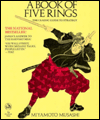
- See other translations:
Translator’s Introduction
- 1 - 4: Includes a background of Japan’s
history. The following
are
some key dates:
- 782: Emperor Kammu starts building Kyoto, including
Butokuden (“Hall of
the virtues of war”) training hall
- 792: Kondei (“Stalwart Youth”) system
established to stiffen the
military
ranks with professional soldiers, often sons of high families
- 1100s: Time of internal strife
- 1390 – 1600: Muromachi period
- 1573: Oda Nobunaga becomes Shogun
- 1582: Nobunaga assassinated. Toyotomi Hideyoshi
continues
reunification
of Japan. Revives practice of samurai wearing two swords,
“Hideyoshi’s
Sword Hunt”
- 1584: Musashi Miyamoto born
- 1589: Hieyoshi dies
- 1600: Tokugawa Ieyasu defeats Nogunaga (son of Hideyoshi)
at battle of
Seki ga hara
- 1603: Tokugawa Ieyasu formally becomes Shogun
- 1616: Ieyasu dies
- 7 - 10:
Shinmen Musashi No Kami Fujiwara No
Genshin, or as
he
is commonly known Miyamoto Musashi, was born in the village called
Miyamoto
in the province Mimasaka in 1584. “Musashi” is the
name of an area
south-west
of Tokyo, and the appellation “No Kami” means noble
person of the area,
while “Fujiwara” is the name of a noble family
foremost in Japan over a
thousand years ago.
Musashi’s ancestors were a
branch of the powerful
Harima clan in Kyushu, the southern island of Japan. Hirada Shokan, his
grandfather, was a retainer of Shinmen Iga No Kami Sudeshige, the lord
of Taktyama castle. Hirada Shokan was highly thought of by his lord and
eventually married his lord’s daughter.
- 10: When Musashi was seven (called Ben No Suke) his father,
Munisai,
either
died or abandoned him. He killed a man with a wooden stick in
single
combat when he was 13. He next defeated Tadashima Akiyama
when he
was 16. He fought with the Ashikaga army against Ieyasu at
Seki
ga
hara.
WHY
ORWELL
MATTERS (2002)
Hardcover
Basic Books, New York
2003-04-06 to 2003-04-15
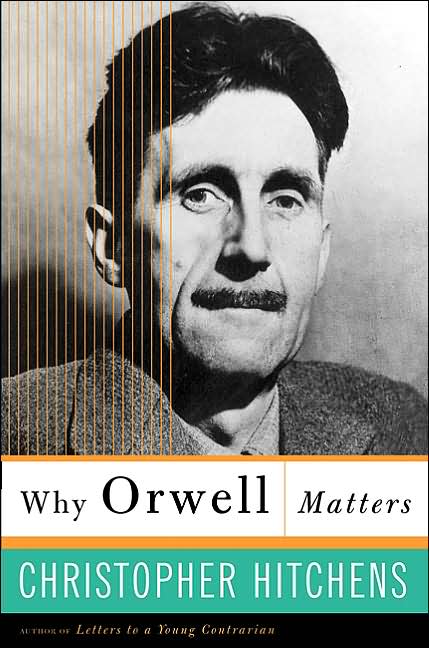
- 3: A humorous writer said—of Mahatma
Gandhi—that saints are always to
be
adjudged guilty until proven innocent. Due to Hitchens’ very
elliptic
writing
style, it is not clear who said that.
- 25: Orwell made use of his BBC radio experience in NINETEEN
EIGHTY FOUR (1948). It was revealed in the late
1970s that
many
of Churchill’s ‘Finest Hour’ speeches
were actually recorded and
delivered
by Mr. Norman Shell, a ‘Children’s Hour’
voice-actor.
- 43: Orwell criticized Gandhi for being too passive in his
resistance.
- 44: Orwell was not satisfied that the Union Jack was raised
before the
Abyssinian flag over Addis Ababa after its deliverance from Italian
fascism.
- 69: A passage that was a precursor to 1984:
The implied objective of this
line of thought is a nightmare world
in
which the Leader, or some ruling clique, controls not only the future
but the
past. If the Leader says of such and such an event,
‘It never
happened’ — well, it never happened. If he
says
that two and two are five — well, two and two are five.
- 88: He coined the term ‘Cold War’ in an
essay called ‘You and the Atom
Bomb’, published 19 October 1945:
We may be heading not for general
breakdown but for an epoch as
horribly
stable as the slave empires of antiquity. James Burnham’s
theory has
been
much discussed, but few people have yet considered its ideological
implications
– that is, the kind of world-view, the kind of beliefs, and
the social
structure that would probably prevail in a State which was at once unconquerable
and in a permanent state of ‘cold war’ with its
neighbors.
- 92: Orwell wrote his only introduction to ANIMAL
FARM (1945) for the Ukrainian edition. Most copies
were seized
in Germany by the American military and turned over to the Red Army for
destruction.
- 148: His story A Clergyman’s Daughter
includes Dorothy losing
an
argument with the village atheist.
- 158: Pavlik Morozov was an official Communist hero with
many statues
built
in his honor. He was a 14-year old ‘Pioneer’ who
had turned in his
family
for hoarding grain and was killed by the angry villagers.
- 189:
Stalin’s propagandists
were fond of saying that they
completed the
first
Five Year Plan in four years; this
was
sometimes
rendered for the simple-minded as 2+2=5.
my
point...
and
I do have one (1995)
Hardcover
Bantam Books, New York
2003-04-20 Read first half, then skimmed the rest

- In a couple places, she mentions being raised Christian
Scientist, and
not using medicine, etc.
- 51: Her mantra about competing in the Iditarod: “Icanarod,
Iwillarod,
Iwinarod, Iditarod”
- 114-115: Coining grouping terms (like a pod of whales, a
murder of
crows):
a rack of lambs, a Naugahyde of animal rights
activists.
THE
COMPUTER
AND
THE BRAIN (1958)
Paperback
Yale University Press, New Haven
2003-04-20 to 2003-04-21
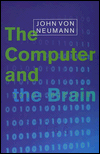
- Originally intended as a Silliman Lecture for Yale
University, von
Neumann’s
health prevented him from ever delivering it.
- 4: Regarding using analog computers to perform
operations. The
“differential
analyzer” has a basic function of (x
± y)/2,
which
can be expanded to perform various functions more efficiently than
arithmetical
operations (x + y, x –
y, xy, x/y).
- 26: Surprisingly, digital machines with precision levels of
1:1010
and 1:1012 are justified, despite typical
mathematical and
engineering
precision levels 1:103 or 1:104.
- 29: A contemporary digital machine might cost $1,000,000.
- 30: He predicted that within another decade, computers
would have
speeds
of 10-8 or 10-9 seconds
per logical action.
- 44: The nature of a neuron, only emitting a pulse when
reaching a
threshold
of input, indicates a “prima facie” digital
character. He admits
this includes some idealization.
- 45: Trans-synaptic stimulation is on the order of 10-4
seconds,
but it may take a neuron 1.5 times 10-2 seconds
to recover
from
fatigue.
- 49: Neurons lead artificial components in volume and energy
consumption
on the order of 108 to 109.
The brain’s
energy
dissipation is on the order of 10 watts.
- 53: Neurons may perform “and” and
“or” operations. Together with
“not”, this allows for a complete set of logical
operators.
- 55: Two important measures of a neuron are threshold
(minimum
stimulation)
and summation time (grace period during which two
arriving
signals
will be considered simultaneous.
- 60: As far as biological memory:
We are as ignorant of its nature
and position as were the Greeks,
who
suspected the location of the mind in the diaphragm. The only
thing
we know is that it must be a rather large-capacity memory, and that it
is hard to see how a complicated automaton like the human nervous
system
could do without one.
- 62: Information in a typed letter of the alphabet contains
2 (upper and
lower case) × 26 (letters) + 35 (punctuation marks
&
intervals)
= 88 alternatives. Should be evaluated at log2
88 ~
6.45
- 64-65: Possible mechanisms for memory include axons having
conduction
varying
with time, genes, and chemicals.
- 70-71: A code may be either complete
(possessing all necessary
parts
to solve a problem) or short (imitating another
system).
- 76: The arithmetical part of the nervous system might have
ten- to
twelve-decimal
precision.
- 79: However, the brain is statistical,
which “...leads to a
lower
level of arithmetical precision but to a higher level of logical
reliability”
QUESTIONING
THE
MILLENNIUM
A Rationalist’s Guide To A Precisely
Arbitrary Countdown (1997)
Hardcover
Harmony Books, New York
2003-04-22 to 2003-04-25
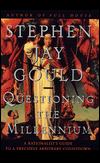
- 50: Modern Seventh Day Adventists, who trace their origin
to William
Miller,
do not salute the flag or join the military because they believe Satan
is currently in control of our unwitting secular government.
- 52: James Watt, Ronald
Reagan’s
secretary of the interior and prominent member of the Pentecostal
Assembly
of God, believed we did not have to worry about environmental damage
because
the world would end soon anyway.
- 59-60: The Ghost Dance movement among Native Americans lead
to the
October
28, 1890 Chicago Tribune headline:
TO WIPE OUT THE WHITES
What the Indians Expect of the Coming Messiah
Fears of an Outbreak
Old Sitting Bull Stirring Up the Excited Redskins
- 73: One of the reasons for the favored interval of 1000
years is 2
Peter
3:8, “But, beloved, be not ignorant of this one thing, that
one day is
with the Lord as a thousand years, and a thousand years as one
day,” as
well as Psalm 90, “For a thousand years in thy sight are but
as
yesterday
when it is past, and as a watch in the night.”
- 144: In 1582, Pope Gregory dropped 10 days from the
calendar (October 4
to 15) by fiat.
- 149: Britain, however, did not accept the Gregorian
Calendar until
1752,
when Parliament dropped 11 days (September 3 to 13).
- 175: Day-date calculators (including his firstborn son
Jesse) take
advantage
of a 28 year repeat cycle: a 7 year cycle based on the addition of a
day
each year and a 4 year cycle based on adding an extra leap-year day
every
4 years. ® However,
my
non-Y2K-compliant
watch at the time did not use this. I think it was set to
“(19)58”
in 2003.
ALAS,
POOR DARWIN
Arguments Against Evolutionary Psychology (2000)
Hardcover
Harmony Books, New York
2003-05-05 to 2003-05-11
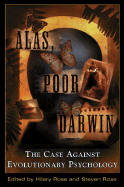
Less Selfish Than Sacred? Genes and the
Religious Impulse in
Evolutionary
Psychology by Dorothy Nelkin
- 25: Claims that
Robert Wright
argues
that the legal system cannot blame individuals for their actions (THE
MORAL ANIMAL (1994), p. 347 & 203).
- 25-26: Mentions the 1995 ABC special “Boys and
Girls are Different”
Anti-Dawkins by Gabriel Dover
-
- 73: Stephen
Jay Gould and
Elizabeth
Vrba coined the word “exaptation” = established
biological functions
that
did not arise as Darwinian adaptations.
More Things in Heaven and Earth by Stephen
Jay Gould
- 119: Wright’s
THE
MORAL ANIMAL (1994) claims that a fondness for
sweetness in
humans
is a “classic example of adaptation that has outlived its
logic,” which
Gould discounts as a “Just-So story”
Sewing Up the Mind: The Claims of Evolutionary
Psychology by
Barbara
Herrnstein Smith
- 162: Pinker
claims that
Artificial
Intelligence work has validated his computational model of the mind,
but
“Rodney Brooks at the
Artificial Intelligence Laboratory
at MIT
[where
Pinker is located] have engineered an impressive menagerie of
intelligent-behaving
automata that operate responsively and appropriately without previously
installed rules, role-governed manipulations or interior symbolic
representations.”
- 164: Stereoscopic vision is not present at birth, but
develops
gradually.
Taking the Stink Out of Instinct by
Patrick Bateson
- 189: This and other essays critique evolutionary psychology
specifically
for its claim that human activities are organized into modules.
- 191: Darwin
wrote a book on The
Expression of the Emotions in Man and Animals
- 196: Konrad
Lorenz was a member
of the Nazi Party. In 1940 he wrote an article that suggested
certain
individuals should be prevented from breeding.
Different Strokes: Beyond Biological Determinism
and Social
Constructionism
by Tom Shakespeare and Mark Erickson
- 234: Disabled people make a distinction between impairment
(a bodily
difference)
and disability (the way that society treats people with impairments).
Escaping Evolutionary Psychology by
Steven Rose
- 307: The rate of evolutionary change is measured in
“Darwins,” how the
average proportional size of any feature alters over the years and is
defined
as one unit per million years. For example, English sparrows
transported
to the U.S.A. have lengthened their legs at a rate of around 100,000
Darwins.
- Says it would be interesting to calculate the spread of
myopia.
- 317: The authors of classic sociobiological papers of the
1970s and
1980s
were asked to reexamine their subjects in Laura Betzig’s 1997
Human
Nature: A Critical Reader. Many
anthropologists were
surprised
at how technological advances in the cultures studied had changed
social
customs.
BOGEYS
AND BANDITS
The Making Of A Fighter Pilot (1997)
Hardcover
Viking Penguin, New York
2003-05-14 to 2003-05-18

- 7: Scott Speicher was likely shot down by a MiG-25 on the
first night
strike
of Desert Storm.
- 19: The concept of a strike fighter was put to the test on
18 January,
1991 when two F/A-18 Hornets took on two MiG-21 fighters while carrying
8000 lbs of bombs each.
- 25: Chuck Yeager and George H. W. Bush would probably never
been
accepted
in the “new” Navy.
- 35: A commanding officer of a RAG explains why he wishes
there were more
women pilots: because each one would not be unique, a cause
célèbre.
- 110: According to Navy aviators, the most serious error in Top
Gun
was that Maverick was going to quit because someone got killed.
- 114-115: Description of crash of F-14 piloted by Kara
Hultgren.
Lt.
Matt Klemish, the RIO, ejected barely within the ejection envelope, but
Hultgren was too late.
- 145: Chapter about the female pilot
“Shrike,” who is obviously Missy
Cummings, a.k.a. “Shrike,” the author of HORNET’S
NEST (1999). In perhaps the most serious
incident, she
cycled
the landing gear of her fighter when it failed to indicate a retraction.
- 268: A favorite poem of aviators is High Flight
by John
Gillespie
Magee, Jr.
Oh, I have slipped the surly bonds of earth,
And danced the skies
on laughter-silvered wings;
Sunward I’ve climbed, and joined the
tumbling mirth
Of sunspit clouds—and
done a hundred things
And while with silent,
lifting mind I’ve trod
The high untrespassed sanctity of space,
Put out my hand, and
touched the face of God.
OUT
OF CONTROL
The New Biology Of Machines, Social Systems, And The
Economic
World
(1994)
Kevin
Kelly (executive
editor
of WIRED)
Paperback
Perseus Books, Cambridge, Massachusetts
2003-05-31 to 2003-06-21

- This was another of the books that the directors of the Matrix
required
Keanu Reeves to read before reading the movie script.
- 3: “vivisystems” = manufactured systems
with features similar to
organic
systems.
- 22: Benefits of swarm systems
- Adaptable
- Evolvable
- Resilient
- Boundless
- Novelty
- 23: Apparent disadvantages of swarm systems
- Nonoptimal
- Noncontrollable
- Nonpredictable
- Nonunderstandable
- Nonimmediate
- 31: Mark Pauline, creator of spectacular battling robots:
Pauline could aim the dragon with a
radio-control
joystick
from a model airplane. He turned Flamethrower’s
snout toward the
audience, who ducked reflexively. The heat, even from 50 feet
away,
slapped the skin. “You know how it is,”
Pauline said later.
“Ecosystems without predators become unstable.
Well, these
spectators
have no predators in their lives. So that’s what
these machines
are,
that’s their role. To interject predators into
civilization.”
- 39: One of the universal biological principles described by
Rod Brooks:
When
something works, don’t mess with it; build on top of it.
- 78: The high oxygen content of Earth’s atmosphere
makes it
unstable.
James Lovelock proposed that any planet that had life would have odd
imbalances
in its atmosphere. Mars and Venus have stable atmospheres,
therefore
they do not harbor life.
- 106: Erwin Schrödinger defined
“negentropy” in the 1950s as a
quality
of the life force to indicate it pushes in the opposite direction as
thermal
decay.
- Chapter 9: Pop Goes the Biosphere
- 151: Tests of the members of Biosphere 2 indicated
increased levels of
pesticides in their blood, despite its absence inside. Due to
their
rapid weight loss, toxins deposited decades earlier were being flushed.
- 239: Mentions Jean
Baudrillard’s
use of “the desert of the real”
- 258-263: Agentinean author Jorge
Luis Borges defines a theory of a library with a continuum of
all
possibilities
written words.
- 289: Parasites replicators in artificial biospheres
- 309: Danny Hillis proposes parasitic programs, which try to
(literally)
crash avionics software, which would ultimately make it stronger.
- 335 & 338: Typical examples of evolved solutions
indicate
cumbersome,
non-intuitive nested functions (trigonometric functions, IF/THEN, etc.).
- 346: Physicist Doyne Farmer proposes a list that defines
life:
- Patterns in space and time
- Self-reproduction
- Information storage of its self-representation (genes)
- Metabolism, to keep the pattern going
- Functional interactions—it does stuff
- Interdependence of parts, or the ability to die
- Stability under perturbations
- Ability to evolve
- 348: Hyperlife = “a particular type of vivisystem
endowed with
integrity,
robustness, and cohesiveness—a strong vivisystem rather than
a lax one.”
- 361: Stephen
Jay Gould
said
that the “morphology of humans hasn’t changed in
25,000 years from
Cro-Magnon.”
- 373:
Natural selection is a very grim natural
reaper.
Darwin made the bold claim that, at the very heart of evolution, many
small
deletions in bulk—many small wanton deaths—feeding
on the throwaway
optimism
of minor variation could, in a counterintuitive way, add up to
something
truly new and meaningful. In the drama of traditional
selection
theory,
death plays the star role. It works single-mindedly by
attrition.
It is an editor that knows only on word:
“No.” Variation
counterbalances
the one-note song of death by giving birth to a new in cheap
abundance.
It too knows only one word: “Maybe.”
Variation cranks out
disposable
“maybes” in bulk, which are immediately mowed down
by death. Bulk
mediocrity is dismissed by wanton death. Occasionally, the
theory
goes, this duet produces a “Yes!”—a
starfish, kidney cells, or
Mozart.
On the face of it, evolution by natural selection is still a startling
hypothesis.
- 374: A scenario for non-random mutation was proposed by Jan
Christaan
Smuts
in 1926, called internal selection. DNA self-repair mechanisms pick and
choose which errors to correct.
- 376: The author poetically describes the (now thoroughly
refuted)
process
of recapitulation.
- 377: The curious thing about monsters, is that there seem
to be
categories
of them, as if following internal laws, such as the position of a
nostril
of a mammal cyclops, or two-headedness, rather than other numbers.
- 390: A human embryo only needed to divide 50 times to
produce the
trillions
of cells needed for a baby.
- 406: Theoretical biologist C.H. Waddington: “Life
might be defined as
the
art of getting away with it.”
- 452: At a Macy Conference on cybernetics, McCulloch said:
I don’t particularly like people, never
have. Man
to my mind is
about
the nastiest, most destructive of all the animals. I
don’t see
any
reason, if he can evolve machines that can have more fun that he
himself
can, why they shouldn’t take over, enslave us, quite
happily.
They
might have a lot more fun, invent better games than we ever did.
- 453: Three theories why the cybernetics movement died:
- Cybernetics was starved to death by the siphoning away of
its funding
to
artificial intelligence.
- It was the victim of batch-mode computing. Those in
charge of
university
mainframes were not willing to commit the computer cycles.
- It tried to put the “observer inside the
box” leading to an infinite
regress
of observers videotaping other observers.
THE
HEDGEHOG,
THE FOX, AND THE MAGISTER’S POX
Mending The Gap Between Science And The Humanities
(2003)
Hardcover
Harmony Books, New York
2003-06-22 to 2003-06-25
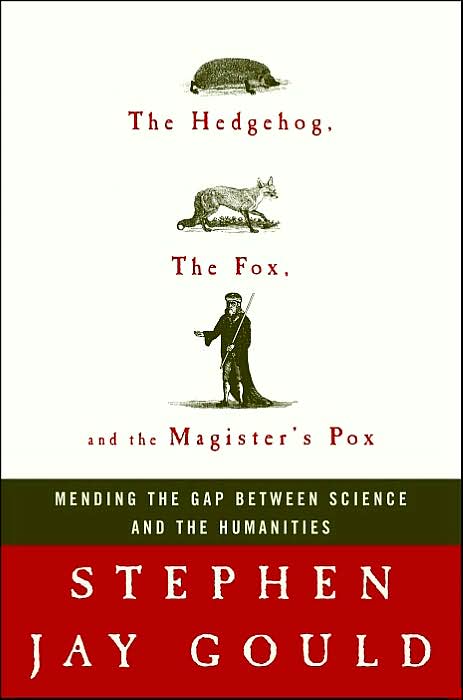
- 1: Russian fairy tales begin with our equivalent of
“once upon a time”: zhili
byli (literally, “lived, was”).
- Includes a long discussion of the method of how books were
censored by
the Papal authority, and not always very completely.
- 106: Gould takes issue with Wordsworth:
Sweet is the lore which nature brings,
Our meddling intellect
Distorts the beauteous forms of things.
We murder to dissect.
- 204: Gould explains in detail the unfortunate incident
where zealous
critics
of E. O.
Wilson pour
water
on him during a debate.
- 242: Discussing Wilson’s quote on ethical issues
(from CONSILIENCE
(1998),
page 260).
- 243: Wilson states on page 262 that moral “codes,
whether judged by
outsiders
as good or evil, play an important role in determining which cultures
flourish,
and which will decline.”
SOPHIE’S
WORLD
A Novel About The History Of Philosophy (1994)
Translated from the Norwegian by
Paulette
Møller
Paperback
Berkley Books, New York
2003-06-25 to 2003-06-27
2007 paperback: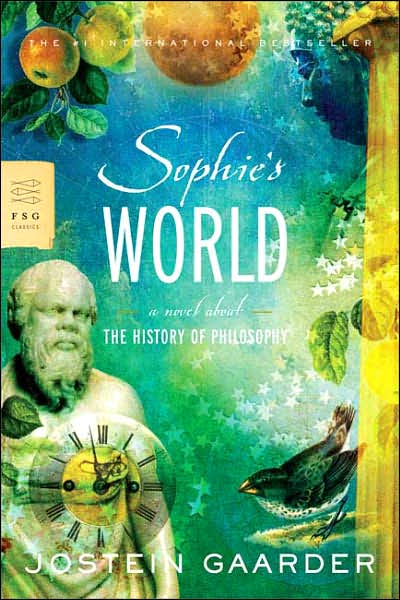
- 52: The Oracle at Delphi
- 54: An excerpt from the Hippocratic Oath:
“I
will give no deadly
medicine
to anyone if asked nor suggest any such counsel, and in like manner I
will
not give to a woman means to produce an abortion.”
- 152: On the origin of “to view” and how
it relates with “insight” or
“to
know”: “wise” and
“wisdom” come from German wissen,
Norwegian
has
viten which has same root as Indian vidya, the
Greek idea,
and the Latin video.
- 175: St. Augustine (354-430 A.D.) belonged to several
religions in his
lifetime, and was instrumental in incorporating many of these ideas
into
Christianity.
- 181: Aquinas Christianized Aristotle the same way that
Augustine
Christianized
Plato.
- 242:
“Our legs can age and
become weak, the back can become
bowed and our
teeth can fall out—but two
and two will go on
being
four as long as there is reason left in us.”
- 327: Kant
made a distinction
between
“the thing itself” and “the thing for
me” = “das Ding an sich”
things
as they appear to us.
- 382: Kierkegaard recognized three
“stages” of life: the aesthetic
stage,
the ethical stage, and the religious stage. People might live at one
stage
all their life.
- 384: One of many references to Ibsen’s story Peer
Gynt.
- 420: Using the peppered moth canard as an example of
Darwinian
Evolution.
- 426:
- 427:
“Sarte
made an important
observation
when he said that existential questions cannot be answered once and for
all. A philosophical question is by definition something that
each
generation, each individual even, must ask over and over
again.”
THE
MATRIX
AND PHILOSOPHY
Welcome To The Desert Of The Real (2002)
Paperback
Open Court, Chicago, Illinois
2003-06-27 to 2003-07-01
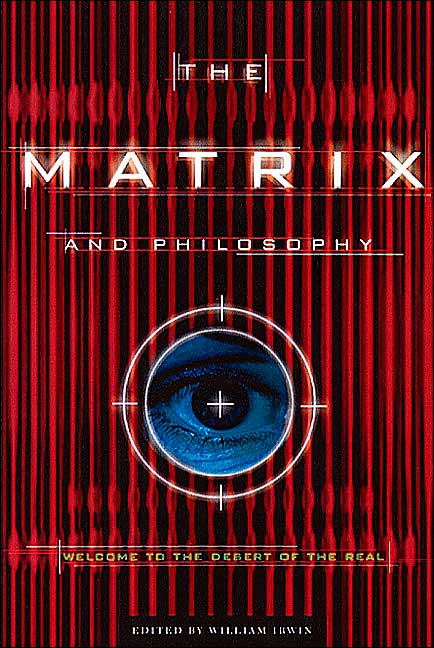
-
Skepticism, Morality, and The Matrix by
Gerald J.
Erion and
Barry Smith
- 20: Descartes
writes, “Whether
I am awake or asleep, two and three added together are five, and a
square
has no more than four sides” in
Meditation.
- 20: While Descartes wrote about an evil demon, Peter Unger
wrote about
an evil scientist in Ignorance (1975).
There is no Spoon: A Buddhist Mirror
by Michael Brannigan
- 105: Zen monk Takuan Soho (1573-1645) instructed Miyamoto
Musashi and Yagyu
Munemori.
Wrote Mysterious Record of Immovable Wisdom
(Fudochishinmyoroku).
Popping a Bitter Pill: Existential Authenticity
in The Matrix and
Nausea by Jennifer L. McMahon
- 170: Nausea by Jean-Paul
Sarte is about an unassuming historian named Roquentin who
suddenly
finds reality disturbing.
The Matrix Simulation and the
Postmodern Age by David
Weberman
- 225 ftnt: The exact moment of the beginning of
post-modernity according
to David Harvey’s The Condition of
Postmodernity was
3:32
p.m. CST on July 15th, 1972 with the dynamiting
of the
modernist
Pruitt-Igoe housing development in St. Louis, Missouri.
The Matrix: Or, The Two Sides
of Perversion by Slavoj
Žižek
- 240 ftnt: The Wachowski brothers cut some of the
“clunky
pseudo-intellectual”
and “Eastern” lines, which can be found in the
original script on the
internet.
- 243: George Seaton’s movie 36 Hours
involves an American
officer
who knows the plans for D-Day being taken to a fake American military
hospital
by the Germans in an attempt to extract what he knows.
- 243: Similarly, in the last two years of Lenin’s
life, Stalin had a
specially
printed copy of Pravda given to him.
- 246: “the ruined Chicago landscape...”
- 256: Concentration camp survivors often mentioned
“the One” who did not
break down in the midst of the de-humanization. Sometimes the One would
break down or be exposed as a fraud.
THE
EMPEROR
AND THE
WOLF
Paperback
Faber and Faber, New York
2003-07-12 to 2003-07-22

- 17: The Great Kanto Earthquake of 1 September, 1923,
Akira’s older
brother
Heigo forced him to look at the bodies.
- 35: Military censors would not allow the portrayal of
people drinking
during
the daytime.
- 43: “Yoi, staato!” =
“Ready, action!”
- 82: When Senkichi Taniguchi offered a role to Mifune in Snow
Trail,
his response (according to Taniguchi) was:
No. I am a man. I understand why
actresses use
their faces
to get parts, but as a man I don’t like that at
all. ...I want to
be a cameraman. I don’t want to be an actor. I
don’t want to have to
rely
on my face to make money. I wasn’t even supposed to be in the
New Face
class, but my friend told me not to quit if I ever wanted to be a
cameraman.
- 128: Rashoman was set in the Eleventh
Century.
- 135: After her breakthrough role in Rashoman,
Machiko Kyo got
leading
roles in Ugetsu and Gate of Hell
(Jigokumon,
1953).
- 150: Yazaemon Otani played Kojiro Sasaki in
Inagaki’s Kojiro
trilogy
(1950-1951), where Mifune played Musashi
Miyamoto in the final movie!
- 151: Kurosawa wrote, Vendetta for a Samurai
(or Samurai
Araki—Duel
at the Key-Maker’s Corner, 1952), staring Mifune,
and directed by
Kazuo
Mori.
- 171: All of the Seven Samurai had
traits based on real-life
samurai,
though not the one’s depicted in the incident. For
example,
Kambei
was based on Isanomukami Koizumi.
- 235: Kurosawa was unique in using real swords, whose weight
added
realism
in how the actors walked.
- 254: Hidden Fortress was set in the
Sixteenth Century.
- 300: Yojimbo set in 1860.
- 361: High and Low lead to an increase
in the rate of
kidnappings.
- 373: Red Beard set in Nineteenth
Century Edo.
- 389: Samurai Assassin set in 1860 and
was based on a real-life
event.
- 392: While in the U.S., Mifune joked, “Also,
while I’m here, I am
buying
a tape recorder and a camera to help restore the balance of
trade.”
- 427: Mifune played Admiral Yamamoto several
times. In 1995, on
the
50th anniversary of Japan’s defeat, an
alternate historical
novel, Deep Blue Fleet, involves
Yamamoto avoiding the
plane
crash, captures Hawaii, granting it independence from the U.S., blowing
up the Panama Canal, then leading Japan’s fight against
Hitler.
The
8-volume novel sold 3 million copies.
- 500: Mifune could not afford to star in movies in the U.S.,
because of
the high tax rate.
- 545: Ran is loosely based on and
alternative take of Motanari
Mori,
the Sixteenth Century warlord whose 3 sons were considered the pillars
of virtue.
- 628: Madadayo comes from
children’s game where the response to Mo
ii kai (“are you ready”) is Mada
da yo (“not yet”).
- 646: Koji Yakusho (star of Shall We Dance)
plays samurai
Koheita
Mochizuki, posing as a drunken magistrate in Dora-Heita (1999).
THE
MYTHMAKER
Paul And The Invention Of Christianity (1986)
Hardcover
Barnes & Noble Books, New York
2003-08-10 to 2003-08-24
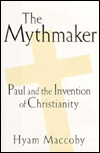
- 6: Despite what is commonly believed, modern scholarship
has shown that
the Pharisees were a moderate and progressive order, held in high
regard
in their time.
- 12: Marcion, who lived about a hundred years after Paul,
considered the
Jewish scriptures, including the Old Testament, as the work of the
Devil.
- 30: Two different versions of the incident where Jesus is
interrogated
about which Commandment he considers the greatest shows an
anti-Pharisee
spin. Mark 12:28-34 is a friendly exchange, where Matthew
22:43-40
removes the pleasantries.
- 44: The lack of parables (a hallmark of Pharisee tradition)
from the
Gospel
of John, indicates subtle revisionism in down-playing Jesus’
Jewish
heritage.
- 46: Four thousand Jews were crucified in a tax revolt
against the
Romans
during the childhood of Jesus.
- 85: Several problems can be found with the story of
Saul’s conversion
to
Paul on the road to Damascus. Saul would not have had the
authority
he claimed.
- 163: Paul declares himself a Roman Citizen (Acts
22:25-29). If
this
was true, did he use church offerings to bribe his way to citizenship?
- 175: There is no continuity between the original followers
of Jesus
(“Nazarenes”)
and those who later called themselves “Christians”
in Antioch.
- 180: Two ancient writings cast Paul in a bad light: The
Pseudo-Clementine
writings, and The Arabic
manuscript discovered by Shlomo
Pines.
- 185: The Gnostic myth is based on the idea that the world
is in the
grip
of evil, and only a visitor from the world of Light can impart secret
knowledge
(gnosis) to allow a privileged few to escape.
- 188: The Gnostics wrote about non-Jewish Biblical
characters such as
Seth,
Enoch (taken alive into heaven), and Melchizedek (priest of the Most
High).
- 188: Paul claims that the Torah was not given directly by
God, but
through
angels (Galations 3:19-20).
- 191: The Gnostics despised the body, as opposed to the
spirit (pneuma,
“pneumatic” = spiritual being)
- 193: Some believed that because they were saved, anything
they did was
correct by definition, so their behavior actually became worse, not
better.
- 198: Paul reluctantly allows marriage as a concession (I
Corinthians
7:1-11)
- 206: Julius Wellhausen famously said, “Jesus was
not a Christian.”
SAVAGE
BEAUTY
Hardcover
Random House, New York
2003-08-12 to 2003-08-21

- 82: Her first big hit poem, Renascence
All I could see from where I
stood
Was three long mountains in a wood;
I turned and looked the other way,
And saw three islands in a bay.
- 153: Floyd Dell was an editor of the radical magazine The
Masses,
which was indicted by the government under the Espionage Act, passed in
June 1912.
- 165: Description of the trial beginning April 15,
1918. The
charge:
conspiracy to obstruct recruiting or enlistment.
- 175 and (xiii): Walter Adolphe Roberts published much of
her work, but
not the sonnet containing the lines:
Whether or not we find what we are seeking
Is idle, biologically speaking.
- 197: Edna suffers a botched abortion.
- 297: Like much of the literati, Edna protests the trial of
Sacco and
Vanzetti
- 349: Terms of endearment: Sniggybus, Skiddlepins,
Scramoodles, Freckles
- 457: Many of the Pacifists from the first World War support
war against
the Nazis. Edna published Make Bright the Arrows
within weeks
of Anne
Morrow Lindbergh’s apologist The
Wave of the Future.
Lindbergh decries a lack of moral fiber:
I do not believe we need to be defended against a
mechanized German
army
invading our shores, as much as against the type of decay, weakness,
and
blindness into which all the ‘Democracies’ have
fallen since the last
war...
There is no fighting the wave of the future.
- 469: Edna is asked to write a poem so the world never
forgets The
Murder
of Lidice, which the Nazis proclaimed, “was now
forever erased from
the map and the memory of the world.”
- 493: The Cult of the Occult was a
satire of T.S.
Eliot’s The Waste Land.
- In her final years, she took massive amounts of morphine.
BLACK
HAWK DOWN
A Story Of Modern War (1999)
Hardcover
Atlantic Monthly Press, New York
2003-08-24 to 2003-08-31

-
- 15: Eversmann never saw Blackburn fall from the helicopter,
as depicted
in the movie. The largest departure from the book is that
Eversmann
and the rest of Chalk 4 left on the Humvee column (see page 236).
- 21: General Garrison sent out three helicopter missions
daily so the
Somalis
would never know which missions were “real.”
- 35: While inside a building, Howe’s Delta team
was mistakenly shot at
by
Rangers outside.
- 36: Johnny Stebbins is the true name of the
coffee-addicted,
chain-smoking
paper-pusher whose first real combat was on that day.
- 46: Several instances of using flashbang grenades to
disperse civilians.
- 49: Staff Sgt Jeff Bray and Sgt Dan Schilling were Air
Force Command
Control
Technicians (CCT) who specialized in air/ground communication.
- 51: Several SEALs were in the Humvee column.
- 60: The Delta operators did indeed hunt game on occasion as
“realistic
training.”
- 62: Ranger saying:
“When the going gets tough, the tough go
cyclic.”
- 71: General Mohamed Farrah Aidid and the Habr Gidr clan may
have
believed
UN Secretary General Boutros Boutros-Ghali was working against them in
favor of the Darod clan.
- 74: The Habr Gidr clan was angered at Americans for
destroying a
conclave
in a helicopter attack with 16 TOW missiles and miniguns.
- 75: Simply the downwash from daily helicopter missions
caused
significant
damage to the flimsy Somali housing. The Somalis felt
harassed.
- 77-78: A QRF Black Hawk had been shot down a week before
and the Somali
mobs had mutilated the bodies of the crew chiefs.
- 99: The Delta team and Rangers were waiting for a signal
from each
other,
until the CCT Schilling got tired of waiting and ran back and forth
between
them.
- 102: Chief Warrant Officer Mike Durant was flying
counterclockwise
orbits,
but his seat was on the right side, limiting his view.
- 107: Durant did in fact try to return to base after his
tail rotor was
hit.
- 110: Fundamentalists, who had brought down Soviet
helicopters in
Afghanistan,
were smuggled through Sudan to give guidance to Aidid’s
men. They
used several tactics such as changing the RPG timing to explode in
midair,
aiming for the tail rotors, and digging holes to shoot vertically.
- 115: After and RPG threw him from his Humvee, Private
Adalberto
Rodriguez
was run over by an Army truck.
- 159: Sizemore cut off his cast to join the rescue mission,
unlike the
movie
where he only threatened to cut it off.
- 201: It took a while for the CSAR team to find survivor
second crew
chief
Ray Dowdy.
- 202: Air Force parajumper Tim Wilkinson quoted from The
Jerk
(shown
in the movie version):
“They hate the cans! Stay away from the
cans!”
- 211: 8 of 11 Rangers in Lt. Larry Perino’s Chalk
One were hit.
- 213: Perino assists Sgt. First Class Kurt Schmid with Cpl.
Jamie
Smith’s
femoral artery.
- 216: Specialist Lance Twombly was ordered by Sgt. Alan
Barton to place
a marker in the middle of the street. In the movie, the
Eversmann/Perino
character heroically places the strobe near Somali forces. In
reality,
the Rangers tended to mark only their own positions.
- 217: One of many instances of killing women and children,
who were
active
as spotters or combatants.
Captain Coultrop nodded his approval. She did, and the D-boy
shot her
down
on the street.
- 221: Pvt. Carlos Rodriguez was also shot in the
pelvis. He was
successfully
treated.
- 222: Medic Wilkinson ran across the field of fire three
times.
“Man, God really does love
medics.”
- 229: Despite his clearly nonsurvivable injury, Delta MSgt.
Tim “Griz”
Martin
remained conscious and strong for hours. His body was not
quite
as
destroyed as portrayed in the movie.
- 229: Pvt. Kowalski who had an unexploded RPG inside him,
still had
vital
signs.
- 231: Black Hawk Super Six Six dropped
off critical supplies,
but
took major damage. It was clear that no Black Hawk could land
near
the Alamo. This was not shown in the movie.
- 233: Sgt. First Class Paul Howe had ideas for better
consolidating
their
position, but was not heeded.
- 240: Captain Mike Steele decides against moving his men.
- 253: Canteens were filled from a drum of water.
- 275: Lamb had a piece of shrapnel between the frontal lobes
of his
brain.
His pinky had nearly come off. He stuck it back on, wrapped
it in
duct tape, and continued working the radio.
- 279: Sgt. John “Mace” Macejunas led a
team on foot to destroy Super
Six Four. The Deltas never linked up with the Alamo
position,
as depicted in the movie.
- 307: Mace did go back out into the field to find American
bodies, by
pretending
to be a journalist.
HOW
WE BELIEVE
The Search For God In An Age Of Science (2000)
Library Binding
Owl Books, New York
2003-09-02 to 2003-09-07

- Preface: Dr. Laura Schlessinger became a member of the Skeptic’s
board of directors after criticizing false memory syndrome. She wanted
to resign her position after the controversial issue “The God
Question.”
- 17: April 8, 1966 Time Magazine cover
story: IS GOD DEAD?
Even scientism, in some extreme
circles, turn into a type of secular
faith where all things come to those who believe.
In fact, science is a type of myth, if
we think
of myths as stories about ourselves and our origins (and not in the
pejorative
sense of myths as things “untrue”).
- 88: Edward Gibbon wrote in his 1781 The
Decline and Fall of the
Roman
Empire:
“The various modes of worship which
prevailed in the Roman
world were
all
considered by the people as equally true; by the philosopher as equally
false; and by the magistrate as equally useful.”
- 88: In Robert Browning’s Pippa Passes:
“God’s in His
Heaven—All’s
right with the world.”
- 127: Pope John Paul II acquitted Galileo’s 1633
heresy in April
1993.
He accepted evolution in October 1996 in an address to the Pontifical
Academy
of Sciences.
- 136:
Most scientists would join the Pope in
voicing their
concerns for the decay of knowledge and truth standards, and the
attacks
from postmodern deconstructionists who claim that science is nothing
more
than a socially constructed myth.
- 151: Joseph Campbell describes functions of myths in Myths
to
Live
By (1972)
- Mystical
- Explanatory
- Normative
- Guidance
- 165: Books on reciprocal altruism:
- Unto Others: The Evolution and
Psychology of Unselfish
Behavior
(1998) by Elliott Sober and David Sloane Wilson
- Adaptation and Natural Selection
(1966) by George
Williams
- The Biology of Moral Systems
(1987) by Richard
Alexander
- 173: Louis Farrakhan talks to Ted Koppel about UFOs on 15
October, 1996 Nightline.
Shermer interprets this is a modern day Ghost Dance.
- 193: Romans celebrated their Millennium in 248 A.D.
VOODOO
SCIENCE
The Road From Foolishness To Fraud (2000)
Hardcover
Oxford University Press, Oxford
2003-09-12 to 2003-09-19
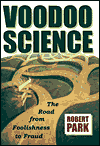
- 9: Definitions
- pathological science: where scientists fool themselves
about
“revolutionary”
results
- junk science: deliberately designed to fool juries and
lawmakers
- pseudoscience: UFOs, magnets, etc. where practitioners
may truly believe
- voodoo science: collective of these three types
- 15: Thursday 23 March, 1989: Martin Fleischmann and Stanley
Pons
announce
Cold Fusion.
- 16: Just after midnight, the Exxon Valdez ran aground in
Alaska.
- 30: The raw data from the Transcendental Meditation
experiment in DC
shows
that the murder rate actually rose!
- 42: A prominent ESP researcher threw out results from
certain people
who
he suspected were choosing wrongly—on purpose!
- 57: The standard homeopathy joke concerns the patient who
died of an
overdose
after taking ordinary water by mistake.
- 58: Senator Royal Copeland of New York gave homeopathy
exemption from
the
FDA in 1938. Consequently, while Nicorette had to complete
clinical
trials, the homeopathic equivalent, CigArrest, did not. 64: Senator Tom
Harkin of Iowa created the Office of Alternative Medicine within the
National
Institute of Health.
- 75: Just before launch, technicians discovered a problem
with the tape
recorder of Sputnik II. They requested a delay, but
Kruschev
refused.
Consequently, the Soviets did not discover the Van Allen radiation
belts.
- 148: During a scare over microwaves, it was discovered that
the Soviets
were beaming microwaves at the American Embassy on Tchaikovsky Street
in
Moscow. Paul Brodeur wrote that they were intended to affect
the
brains of the Americans. We now know that they were for
powering
listening devices.
- 182: Andrei Sakharov spoke at an award ceremony for Edward
Teller’s
contribution
to SDI. After Sakharov warned that Teller’s support of SDI
was a “grave
error,” master of ceremonies William F. Buckley Jr. said
Sakharov was
“A
nice man, but clearly out of touch with reality.” Teller
hides behind
government
secrecy, “If you only knew what I know.”
- 184: The X-Ray laser intended for SDI was really a myth.
- 190: France invested $200 million in aerial mineral
detection called
l’avion renifleur, which turned out to be a hoax.
The embarrassed
government
attempted to keep the whole affair secret.
THE
MEANING OF IT
ALL
Thoughts Of A Citizen Scientist (1963)
Hardcover
Helix Books, Reading, Massachusetts
Read entirely on 2003-09-19
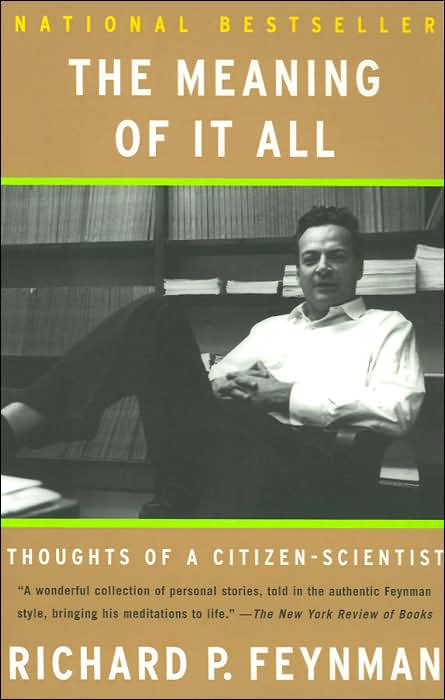
- Based on three talks in April 1963 at the University of
Washington
(Seattle)
as part of John Danz Lecture Series.
- 65 - 66: If two presidential candidates were asked on, say,
the Farm
Question,
and one immediately had an answer, but the second merely gave
principles
on how he would study it, voters would probably favor the former.
- 97: A health food salesman tells his customers about how
the Federal
Pure
Food and Drug Act regulates labels on bottles. Then he tries
to
sell
bottles of his product saying that he was in too much of a hurry to put
the labels on, so they could just buy it and put the labels on
themselves.
- 112 b: He gets sick of hearing media reports critical of
the problems
with
the Ranger space program. Even by failing, we learn something.
- 116: On spelling:
Now let me get to a lower level still in
this
question.
And that is, all the time you hear the question, “why
can’t Johnny
read?”
And the answer is, because of the spelling. The Phoenicians,
2000,
more, 3000, 4000 years ago, somewhere around there, were able to figure
out from their language a scheme of describing the sounds with
symbols.
It was very simple. Each sound had a corresponding symbol,
and
each
symbol, a corresponding sound. So that when you could see
what
the
symbols’ sounds were, you could see what the words were
supposed to
sound
like. It’s a marvelous invention. And in
the period of time
things have happened, and things have gotten out of whack in the
English
language. Why can’t we change spelling?
Who should do it if
not the professors of English? If the professors of English
will
complain to me that the students who come to the universities, after
all
those years of study, still cannot spell “friend,”
I say to them that
something’s
the matter with the way you spell friend.
Did you know that they can write
any language with an alphabet so
that
you can read how it sounds in any other language when you hear
it?
That’s really something. So they ought to be able
to do it in
English
alone.
QED
The Strange Theory Of Light And Matter (1985)
Hardcover
Princeton University Press, Princeton, New Jersey
2003-09-19 to 2003-09-20
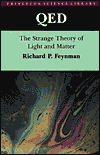
- Based on three talks which were the first Alex G. Mautner
Memorial
Lectures
at UCLA, given in 1983.
- Basically, he discusses quantum electrical dynamics, which
involves
drawing
lots of little arrows and creating vector summations that correspond to
macroscopic optical events like reflection and refraction.
Also
lots
of discussion of diffraction gratings and the ubiquitous Feynman
diagrams.
- 89: Light can travel faster that c over
very short distances.
but there is also an amplitude
for light to go faster (or slower)
than
the conventional speed of light. You found out that in the
last
lecture
that light doesn’t go only in straight lines; now, you find
out that it
doesn’t go only at the speed of light!
- 118 caption: When an electron emits or absorbs a photon,
coupling or
junction
number (j).
As of 1983, the theoretical
number was 1.00115965246 with an
uncertainty
of about 20 in last 2 digits; the experimental number was
1.00115965221,
with uncertainty of about 4 in the last digit. This accuracy
is
equivalent
to measuring the distance from Los Angeles to New York, a distance of
over
3,000 miles, to within the width of a human hair.
- 129 - 130: Searching for a theoretical value of e.
Every once in a while, someone
notices that a certain combination of
pi’s and e’s (the base of the natural logarithms),
and 2’s and 5’s
produces
the mysterious coupling constant, but it is a fact that you would be
surprised
how many numbers you can make out of pi’s
and
e’s and so on.
For the d
quark the amplitude to couple with a
photon is
–1/3,
and for the u quark it is +2/3. (Had
Benjamin Franklin
known
about quarks, he might have at least made the charge of an electron
–3!)
- 139–140: Beta decay, when a neutron disintegrates
in to a proton,
changes
the “flavor” of one quark from d
to u. This is
the
type of radiation that has people worried about nuclear reactors.
CODE
OF THE SAMURAI
A Modern Translation Of The Bushido
Shoshinsu (1999)
Hardcover
Tuttle Publishing, Boston

The process of cultivating the practice
of doing
right
begins with fear of being disrespected by those close to you, starting
with your family and servants, then advances to refraining from doing
wrong
and deliberately doing right from fear of incurring the shame of being
censured and ridicules by society at large. If you do this,
it
will
naturally become habitual, so eventually you develop a mentality that
prefers
to follow what is right and disdains to do wrong.
Whenever you sleep, don’t
point your feet in the
direction
of your employer. Where you set up straw bundles for archery practice,
don’t let the arrows land in the vicinity of your employer,
and when
you
set your spear and sword on their racks, don’t point the tips
toward
him.
- 26: Story of Kani Saizo receiving a gift of quail while
napping.
Upon realizing the quail had been caught by the falcon of Lord
Masanori,
he got up, and put on formal clothes to receive it, and admonished his
servant.
- 36: The chapter on relatives points out that if your
brother is the
head
of the household, then his son must be treated as an heir, not as your
nephew.
- 72: Do not wear a jacket and suit with your
overlord’s crest because
that
is how the overlord’s family dresses. You should wear a
jacket with
your
own crest. Also, when clothes are worn out, the
overlord’s crests
should be cut out and incinerated so as not to soil them.
REPUBLIC
Hardcover
Barnes & Noble Books, New York
2003-09-20 to 2003-09-26
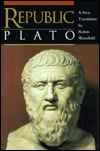
- xi b: The title Republic is a bad
translation of the Greek polieia
= ‘political system’ which is usually translated as
the Latin res
publica
= ‘political business’.
- 27: Begins with a dialog between Thrasymachus and Socrates:
‘So you see, Socrates,
immorality—if practised on a
large enough scale—has more power, license, and authority
than
morality.
And as I said at the beginning, morality is really the advantage of the
stronger party, while immorality is profitable and advantageous to
oneself.’
‘Well, here’s the
question I was getting at just
now;
I think it’s the logical next one for our investigation. When
morality
is compared with immorality, what do we learn about morality? I mean,
the
suggestion was made that immorality is more powerful and more effective
than morality; but the fact that we’ve now established that
morality is
a good state and in knowledge will make it easy to prove, I think, that
it’s also more effective than immorality, given that
immorality is
ignorance,
as everyone knows by now. However, I don’t want our
investigation to be
couched in such abstract terms, Thrasymachus, but rather as follows:
would
you agree that it is wrong for a community to undertake the domination
of other communities, to deprive other communities of their freedom,
and
to keep a number of other communities subservient to itself?’
- 73: Socrates argues that children should only be exposed to
certain
G-rated
stories. He doesn’t even think they should be told
about Homer’s
battles between gods, because kids do not know when they are
allegorical.
- 79: His conclusions that gods do not lie or change their
character is
based
on the premise that the gods are perfect.
- 173 & 175: He proposes a system where seemingly
random arranged
pairings
through religion and rites will mask a subtle eugenics.
- 175: When men and women get past the age of procreation,
they will be
able
to have intercourse with anyone they want. However, if a
child is
conceived, it should be aborted.
- 211: Philosophers on philosophers:
‘Anyway, there’s no
need for us to have a whole
array
of the philosopher’s characteristics line up all over again.
I’m sure
you
remember how we found that philosophers naturally have courage,
broadness
of vision, quickness of learning, and a good memory.’
- 240: The famous “Allegory of the Cave”.
- 296 - 297: They find all kinds of problems with democracy:
‘You’re not forced
to hold political office in this
kind of community,’ I said, ‘even if
you’d be good at it; you’re not
forced
to be a subject either, unless you want to. You don’t have to
go to war
when there’s a war on, or to keep the peace when everyone
else is, if
peace
isn’t to your liking. Then again, even if you’re
legally forbidden to
play
a part in governmental or judicial procedures, you can still do both,
if
you feel like it. Isn’t this an extraordinarily pleasant way
to spend
one’s
life, in the short term?’
‘So suppose you wanted to put
it the other way round
and state how far a king is from a dictator in terms of the truth of
pleasure,
the completed multiplication would show that his life is 729 times more
pleasant than a dictator’s. And a dictator is that much more
wretched
than
a king.’
- 371: A near-death experience describes the afterlife.
WALDEN
TWO (1948)
Paperback
The MacMillian Company, New York
2003-09-27 to 2003-09-28

- Professor Burris: Narrator
- Rogers: Former student.
- Barbara Macklin: Rogers’ fiancée
- Steve Jamnik: Rogers’ army buddy.
- Mary Grove: Jamnik’s girl.
- T. E. Frazier: Former acquaintance of Burris, founding
member of Walden
Two.
- Professor Castle
- 14: Some Utopians in literature:
- REPUBLIC
by Plato
- Utopia (1516) by
Sir Thomas More
- The New Atlantis
(1626) by Francis Bacon
- Looking Backward: 2000 –
1887 (1888) by Edward
Bellamy
- Shangri-La
- 20: Sheep keep the lawn mowed. At one time, they
were surrounded
by an electric fence, but that was substituted by a piece of
string.
Nevertheless, even sheep who came after the electric fence do not
approach
the string.
- 52: Different credit value are assigned to different kinds
of work, as
in Looking Backward: 2000 – 1887
(1888) by Edward
Bellamy.
- Children are raised collectively.
- 108: To teach children self-control, they must keep
lollipops hanging
around
their necks. This is the same principle where they could
drink
cocoa
with less and less sugar.
- 160: News From Nowhere, or, An Epoch of
Rest Being Some Chapters
From a Utopian Romance (1892) by William Morris
- 169: Personal competition is discouraged.
- 171: Expressions of personal gratitude are prohibited by
the Code.
- 193: Erewhon (1871)
by Samuel Butler (title is “nowhere”
backwards).
- 235: Management is concealed and the Managers are more
likely to be
considered
servants than masters.
- 235: Any sense of history is discouraged.
- 237 - 239: Along the same lines, they don’t teach
world history,
although
people may read as much history as they like.
- 239:
“I can’t believe
you’re serious,” said Castle. “Are
you saying that you gain no perspective—I mean, no detached
opinion—from
a sense of history?”
“I mean that and nothing more.
Nothing confuses
our evaluation of the present more than a sense of
history—unless it’s
a sense of destiny. You Hitlers are the men who use history to real
advantage.
It’s exactly what they need. It obfuscates every attempt to
get a clear
appreciation of the present.
“Race, family, ancestor
worship—these are the
handmaidens
of history, and we should have learned to beware of them by now. What
we
give our young people in Walden Two is a grasp of the current
forces
which a culture must deal with. None of your myths, none of your
heroes—no
history, no destiny—simply the Now! The
present is the thing.
It’s
the only thing we can deal with, anyway, in a scientific way. But
we’ve
got a long way from the dictator. Have I satisfied you that I have no
personal
ambitions, Mr. Castle?”
- 261: Jesus as an early discoverer of positive
reinforcement.
Loving
your enemies gives you peace of mind and will eventually allow you to
control
the stronger man.
- 275: Differences between Communist Russia and Walden Two:
- A decline in the experimental spirit.
- Russia is overpropagandized which overrides data.
- The use of heroes.
- Russia is based on power, the people have to want
to behave
for
mutual good.
- 286: While Rogers is not planning to stay, Steve and Mary
are eager to
join in and get married.
- 300:
“What is love,” he
said, with a shrug, “except
another
name for the use of positive reinforcement?”
“Or vice versa,” I
said.
WAGING
MODERN WAR
Bosnia, Kosovo, And The Future Of Combat (2001)
PublicAffairs, New York
2003-10-26 to 2003-11-06

- 62: Former Assistant Secretary of Defense Richard Perle
represented
Bosnians.
- 93: Milosevic intercepts a private memorandum from Clark to
General
Shinseki.
- On two occasions, Clark was “caught”
giving advice to the Secretary of
Defense.
- He admits manipulating hard-line Serbs. By
humiliating them,
their
opponents did better in elections.
- 196: On the first night of bombing, three MiGs were shot
down,
including
one downed by a Dutch F-16.
- 198: A new federal law delayed deployment of Apache
helicopters.
- 209: Two more MiGs are shot down by a U.S. F-15C using
beyond-visual-range
missiles.
- 214: A U.S. missile ends up in Bulgaria. On a
Saturday night,
news
that an F-117 was shot down. When the pilot was retrieved, he
asked
that his name not be released.
- 229: Three American servicemen are captured by the Serbs.
- 255: Two accidental bombings of civilians.
- 255 & earlier: The French veto certain targets.
- 263 - 264: He planted a story about targeting a Serb TV
transmitter.
The Serbs then ordered all international journalists to report to the
Serb
TV building.
- 266: Stuck President Milosevic’s command bunker,
under his house at 15
Uzicka Street in Belgrade.
- 267: Summary after four weeks; one aircraft lost, no pilots
lost, and
no
bombing pause, yet they could not stop the ethnic cleansing and
petroleum
was being imported legally.
- 273:
“Wes, at the White House
meeting today there was a
lot
of discussion about your press conference,” Shelton began.
“The
Secretary
of Defense asked me to give you some verbatim guidance, so here it is:
‘Get your f——g face off the TV. No more
briefings, period. That’s it.’
I just wanted to give it to you like he said it. Do you have any
questions?”
- 274: More setbacks including the loss of a Marine Harrier
over the
Adriatic
(due to mechanical problems) and an F-16 in combat over Serbia.
- 281: Two Apaches were lost due to training, one incident
killing both
crewmen,
yet they still had not been allowed to deploy in combat.
- 296: A cluster bomb “functioned” at too
high an altitude, missing the
target
and resulting in civilian casualties. Of 1,500 cluster bombs,
this
was only the second malfunction.
- 335: Helping the KLA keep the top of Mount Pastrik.
- 369: The French offer to put airborne troops in Pristina
Airport.
- 370: In negotiations, the Pentagon drops provision of
return of
Albanian
prisoners.
- 371: Mike Jackson and Clark don’t take the French
up on their airport
offer.
- 380: Problems with deploying NATO forces to Pristina
Airport.
Among
other things, they wanted a well-defined mission to avoid an
unnecessary
firefight after the war was essentially over.
- 390: The Russians divert forces from Bosnia to Pristina
Airport, all
the
while insisting that it was an “unfortunate”
mistake. Concerned
that
this would result in partition.
- 399: NATO commanders’ orders are subject to
“red-carding”, where
nations
temporarily withdraw their own forces from certain actions.
- 412: The Russians begin ceding control of Pristina
Airport.
However,
some Eastern European officers suspect that because NATO was not
willing
to intervene, that Russia would be more likely to renew war in Chechnya.
- 418:
Moreover, a ground invasion was
avoided, no airmen died, the
precious
Danube bridges in Belgrade were not struck, the war did not spread into
the surrounding states, and the financial costs were surprisingly
little.
Using military force effectively
requires departing
from the political dynamic and following the so-called
“Principles of
War”
identified by post-Napoleonic military writers a century and a half
ago.
Every military officer learns them in early training. Most of us spend
a lifetime understanding how to apply them.
As formulated in modern American
studies, the
Principles
of War are defined to include having a clear objective
and
relying
on unity of command to focus all efforts toward
this aim. Plans
and operations should be simple in conception, massing
forces
at the most critical points, relying on economy of force
in the
peripheral areas, and achieving surprise over the
enemy. Forces
must attend to their security. Decisive results are
obtained
from offensive
action and maneuver.
- 432: By 1972, the Thanh Hoa bridge over the Red River near
Hanoi had
been
subject to 700 strikes, but had not been destroyed. Eight
American
fighters had been lost. But the first laser-guided bomb
strike
took
it out.
THE
LIGHT OF OTHER
DAYS
(2000)
Hardcover
TOR Books, New York
2003-10-28 to 2003-10-29

- 13: The International Space Station was not completed due
to the crash
of a Space Shuttle in 2010.
- A large trans-Neptunian object (called Wormwood) will
impact the Earth
in 500 years.
- 53: The Russian word for “Wormwood” is
“Chernobyl”.
- 57: Henrik Ibsen:
One should never put on one’s best trousers
to go out to
battle for
freedom
and truth.
- Hiram Patterson is an industrialist with two sons, Bobby
and David (who
did not know of each others existence until recently).
- The invention of the WormCam allows view of other times and
places via
wormholes. Privacy is immediately lost.
- 101: Photos have not been admissible in court since 2010.
- Edward Gibbon (1737 – 1894):
History. . . is indeed little more than a chronicle
of the crimes,
follies
and misfortunes of mankind.
- FBI Special Agent Mavens confronts Hiram about WormCam.
- 212: Chapter 21 “Behold The Man”
describes the 12,000 Days Project,
which
follows the life of Jesus.
- 220: His actual death was unviewable because all the
available
wormholes
have been used, presumably by WormCams from future people.
- 259: Chapter 26 involves traveling along a line of
mitochondrial DNA
though
a succession of grandmothers, all the way back to Africa.
- 285: The obligatory mention of Omega Point, invented by
Teilhard de
Chardin,
which is sort of how the book ends.
- 291: Chapter 28 “The Age of Sisyphus”:
traveling along DNA through the
entire history of life, including several Pre-Cambrian Ice-Ages; and
then
to the point where intelligent beings buried thermophiles (our
ancestors)
in preparation for a cometary impact.
PUNK’S
WAR (2001)
Paperback
A Signet Book, New York
2003-11-08 to 2003-11-09

- Punk: F-14 pilot. Has to decide whether to remain
a Naval
Aviator,
or to move on to airlines.
- Spud: Punk’s RIO.
- Commander “Soup” Campbell: Squadron
commander who taught at Top Gun (“The
School”) and flew with the Blue Angels (“The
Team”).
Succeeds
despite severe mistakes, including being captured by Iraq.
- Einstein: Soup’s green RIO.
- Jordan: Punk’s stateside girlfriend who tires of
waiting for him.
- The Pats: Androgynous intelligence officers for the
squadron.
- 25: Motto of the intel geeks:
In God we trust, all others we monitor.
- 258: With the addition of the LANTIRN pod, the F-14
actually became the
preferred Navy strike fighter over the F-18 Hornet.
- 274: Recollection of Admiral Stockdale upon descending into
North
Vietnam:
I am leaving the world of technology and entering the
world of
Epictetus.
- When hostilities build up in Iraq, Punk is sent to joint
mission
planning.
The pilots wonder whether they will continue their fruitless No-Fly
Zone
monitoring, or whether they will be able to conduct Punk’s
War.
THE
SANDMAN (1988)
Hardcover Trade Paperbacks
DC Comics
Re-read 2003
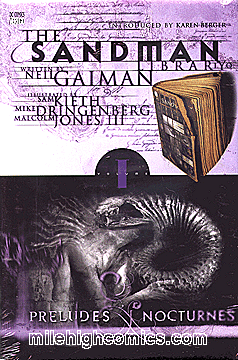

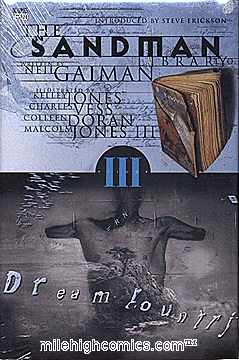
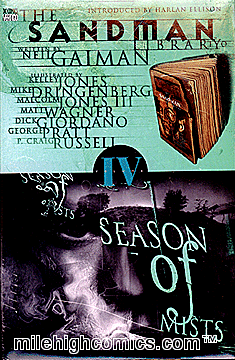







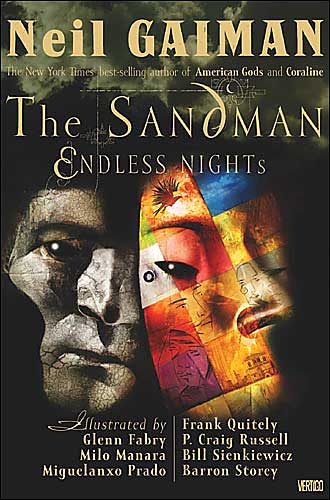
COMMUNICATION
WITH EXTRATERRESTRIAL INTELLIGENCE
(CETI, 1973)
Paperback
The MIT Press, Cambridge, Massachusetts
2003-11-18 to 2003-12-01
- These are the proceedings from a multidisciplinary
conference held in
Soviet
Armenia in 1971.
- 4 - 5: Sagan:
The word CETI which has been devised for
this
meeting
is I think appropriate in three different respects. First, it is an
acronym
for Communication with Extraterrestrial Intelligence. Second, it is the
Latin genitive for whale, which is of some interest to this discussion;
the cetaceans are undoubtedly another intelligent species inhabiting
our
planet, and it has been argued that if we cannot communicate with them
we should not be able to communicate with extraterrestrial
civilizations.
And finally, one of the two stars which was first examined by Frank
Drake
in Project Ozma, the first experimental undertaking along those lines,
was Tau Ceti.
- 5: Chapters are broken down into terms from the Drake
Equation:
N = R*fpnef1fifCL
- 19: Thomas Gold: Mercury is caught in a solar resonance so
that it
turns
1.5 times per orbit.
- 23: Gold: Venus appears to have started with a retrograde
spin, but was
slowed down by tidal friction. It is in a resonance with
Earth,
in
the 5th possible mode.
- 30: Sagan speculates that the Earth of 4 billion years ago
was near the
freezing point of water. However, ammonia would have been a
liquid.
- 66: Sagan:
Philip Morrison has stressed that
the discovery of life on Mars
would
convert the origin of life from a miracle to a statistic.
- 88: Richard Lee points out that an intelligent animal would
have to
have
an adequate blood supply to the brain, which disqualifies the giraffe.
- 91: Lee:
Here we come to the heart of the
matter: Human
intelligence
reduced
to its essentials is synonymous with human language.
Intelligence
is
improved communication, the transmission of more complex information
from
one individual to another.
- 122 - 123: Gold supposes an outlandish concept of ant-like
beings that
communicate with electrical contacts, which could lead to a collective
intelligence.
- 125: Marvin Minsky:
On the question of extraterrestrial
intelligence, I
think that, at least from what we know about intelligence now, there
are
certain
aspects of intelligence that would be necessary even if one disagreed
about
details. The ability to use knowledge is important in intelligence. It
is probably very important to be able to get knowledge and transmit it.
It is not very important to be able to generate it. The ability to
create
new ideas is very unimportant if you are in a culture. None of us
generates
very many ideas, or at least we don’t recognize our
debt—that with each
word in a language we learn comes from out culture. It is probably
easier
to communicate with a Jovian scientist that with an American human
teenager.
- 152: Books by Anatole Rapaport on nonzero game theory:
- Two-Person Game Theory
- Prisoners’ Dilemma
- The Big Two
- 156: G. Stent:
But with the rise of civilization, as
has been
outlined
for us by Lee and Flannery, and particularly with the appearance of the
first economic surplus, it became possible to sublimate this will to
power
to higher spheres beyond the concern for daily survival, beyond the
strife
for the next meal. Eventually there appeared an extreme form of the
sublimated
will to power, which had come to be almost completely divorced from
economic
activity, a psychotype which some German philosophers of the nineteenth
and twentieth centuries have referred to as Faustian man. Faustian man
is the embodiment of the extreme will to power. His view of the world
is
one of constant struggle. And since he sees in struggle the very
essence
of his existence, Faustian man is never satisfied. Ironically he is
that
ideal type whom the economists of the nineteenth century had in mind
with
their idea of the economic man. And Faustian man became the mainspring
of progress. That is, being never satisfied, he was always struggling,
always pushing ahead, always trying to gain greater dominion over
nature,
even if his own personal situation was, in fact, economically secure.
- 175 t: S. Von Hoerner: Colonizing other planets to limit
the population
would not be very effective. If there are 30,000 inhabitable
planets
within 50 parsec = 150 light year radius, and we start with one today
and
increase with 2% a year, it would only take 500 years for them all to
be
as densely populated as the Earth is now.
- 175 b: 10% of all human effort goes into weapons.
The accumulated
destructive power amounts to 10 tons of TNT per person, resembling a
ball
of dynamite 2 meters in diameter.
- 176: Genetic degradation takes place because medicine
eliminates
natural
selection while mutations still go on.
- 186: R. G. Podolny suggests that a UFO incident from a
monastery clerk
in Northern Russia on August 15, 1663 might have been an interplanetary
probe.
- 257 & 261: Tables of local astronomical objects
examined for CETI.
- 289: B. M. Oliver: If we search one million start in 30
years, then we
can only devote 1000 seconds per star.
- 304: Gold:
I am reminded of a quotation from
the House of Commons some years
ago:
“Why should I do this for posterity? What has posterity done
for me?”
THE
PUZZLE PALACE
A Report On America’s Most Secret Agency (1982)
Hardcover
Houghton Mifflin Company, Boston
2003-12-02 to 2003-12-19

- 9: Herbert O. Yardley set up America’s Black
Chamber at 3 East 38
Street,
New York. Post Office Box 354, Grand Central Station, New
York
was
used for all correspondence.
- 12 - 13: On 5 March, 1921, American sub chaser 154 fired a
warning shot
at the Western Union cable ship Robert C. Clowry to prevent it from
laying
a
cable and creating a communication monopoly between North and South
America.
- 16 - 17: Secretary of State Henry L. Stimson ordered a stop
to
interception
of messages with the famous quote:
gentlemen do not read each other’s mail.
- 19: The American Black Chamber
(1931) by Yardley was an
exposé.
- 24: The manuscript for his second book, Japanese
Diplomatic
Secrets,
was impounded by the government, an practice unheard of before or
since.
It was not declassified until 1979.
- 25 - 26: The closest thing to an Official Secrets Act was
H.R. 4220, of
which a slightly changed version remains as Section 952 of Title 18 of
the United States Code.
- 35: The Army and Navy then set up their own decryption
efforts.
In
order to reduce duplication, the Navy would translate Japanese
diplomatic
intercepts originating on odd days and the Army would handle even days.
- 81 - 83: After two suspected homosexuals from the Agency
defected to
Moscow,
a McCarthy-type purge forced dozens of employees to resign.
When
one agent was questioned, he openly admitted that he was gay and
refused
to resign. A compromise was reached so that if he informed
his
family
(so that he would not be susceptible to blackmail), then he could keep
his job.
- 95: $110 million was wasted on aircraft black
boxes. It was
unrealistic
to think that fighter pilots would wait to synchronize the systems in
the
midst of combat.
- 121: A photograph that ran in the New York Times
Magazine
showed
the secret codeword DINAR. It cost $250,000 to replace the
codeword.
- 124: In 1978 thirteen members of the military assigned to
the NSA were
subsequently not allowed in as civilians due to polygraph testing.
- 130 - 131: A scandal was uncovered in 1954 where Joseph
Sidney
Peterson,
Jr. passed secrets to the Dutch government.
- 131 - 132: It was easy to find which documents were
compromised because
their rounded, American-type staples had been replaced with squared-off
Dutch staples.
- 137: During the Cold War, several reconnaissance planes on
NSA missions
were secretly lost.
- 139: Shocked about the recent EC-130 incident, NSA
employees William H.
Martin and Bernon F. Mitchell inform Representative Wayne Hays about
these
secret operations.
- 140: Disenchanted with American values, Martin and Mitchell
defect to
the
Soviet Union, where they believed they would be socially
accepted.
They revealed secrets on Soviet television.
- 149: After their very public defection, the NSA was
pressured by HUAC
to
fire 26 employees for “indications of sexual
deviation”.
- 150 - 152: Despite his meager Army salary, Jack Edward
Dunlap began to
spend lavishly. Nobody seemed to question where he got this
money
from. For years, he sold secrets to the Soviets.
After a
few
attempts, Dunlap committed suicide.
- 153: Victor Norris Hamilton defected to Moscow and told his
story on
the
front page of Izvestia.
- 165: Communication of the death of cosmonaut Vladimir
Komarov was
intercepted.
- 167: West Virginia has a 100 square mile National Radio
Quiet Zone.
- 179: Radio transcript of EC-130 being shot down by Soviets.
- 183 - 184: An East German writer once reported that 11 of
the 17 member
crew were caught on the outskirts of Yerevan, but their fate remains
unknown.
- 184: In fact, there were at least 33 aircraft incidents
since the early
1950s.
- 200: Before they became hostages themselves, the American
Embassy staff
in Iran negotiated the release of American intelligence workers at a
listening
post. The loss of the listening post after the Iranian
Revolution
was a significant setback.
- 201: In order to spy on Soviet missile tests, the U.S.
teamed up with
China
to operate listening posts.
- 222 - 225: During the Six Day War, Israel
“mistakenly” attacks the NSA
radio intercept ship Liberty, killing 32 crew
members and
wounding
2/3 of the rest.
- 235: The loss of a second SIGINT ship; Pueblo
was captured by
North
Korea.
- 242: Secretary of Defense James Forrestal tells members of
the Senate
Judiciary
Committee about Operation Shamrock, which included the interception of
domestic communications.
- 243 - 244: Due to his paranoia, Forrestal is admitted to
Bethesda Naval
Hospital and commits suicide.
- 250: The FBI, Secret Service, and CIA add names to a watch
list of
political
agitators to be survailed, including Jane Fonda, Joan Baez, Dr.
Benjamin
Spock, Dr. Martin Luther King, Jr., the Reverend Ralph Abernathy, Black
Panther leader Eldridge Cleaver, and Chicago Seven defendants Abbie
Hoffman
and David T. Dellinger.
- 285 - 286: On the Pentagon Papers:
“The security of the Nation is
not at the ramparts
alone.
Security also lies in the values of our free institutions. A
cantankerous
press, an ubiquitous press must be suffered by those in authority in
order
to preserve the even greater values of freedom of expression and the
right
of the people to know.” With those eloquent words Judge
Gurfein, on
June
19, 1971, decided the historic case in favor of the Times,
though
continuing the restraining order to give the government time to appeal.
- 288: Nixon gathers “The Plumbers”,
including gun-nut G. Gordon Liddy.
- 295:
Old NSA officials never die; they simply become
consultants.
- 311: Churchill cooperates with the U.S. on
intelligence. Mention
of Bletchley Park, including a single mention of Alan
Turing.
- 312: While decoding the Japanese Purple code, William F.
Friedman
experiences
psychological problems. He was admitted to Walter Reed
Hospital
on
January 5, 1941 after having a nervous breakdown.
- 319: Egyptian leader Colonel Gamal Abdel Nasser tries to
evict the
British
from the Suez Canal.
- 354 - 355: Carl Nicolai invents the Phasorphone:
Nicolai had suddenly been assaulted with
one of the
oldest weapons in the nation’s national security arsenal: the
Invention
Secrecy Act. Passed in 1917 as a wartime measure to prevent the
publication
of inventions that might “be detrimental to the public safety
or
defense
or might assist the enemy or endanger the successful prosecution of the
war,” the measure ended with the conclusion of World War I.
The act was
resurrected in 1940 and was later extended until the end of the Second
World War. Then, like the phoenix, it once again rose from the ashes
with
the passage of the Invention Secrecy Act of 1951, which mandated that
secrecy
orders be kept for periods of no more than one year unless renewed.
There
was a catch, however. The act also said that a secrecy order
“in
effect,
or issued, during a national emergency declared by the President shall
remain in effect for the duration of the national emergency and six
months
thereafter.” Because no one ever bothered to declare an end
to
President
Truman’s 1951 emergency, the emergency remained in effect
until
September
1978.
The major problem with the two
revolutions, the
tremendous
advances in the use of satellite and microwave technology and the
enormous
growth of SIGINT, is that they have left a void where there should have
been a third revolution: the law. Three decades after its creation, the
NSA is still without a formal, statutory charter, the first reform
called
for by the Church Committee. Instead, there is a super hush-hush
surveillance
court that is virtually impotent; the FISA, which has enough loopholes
and exceptions to render it nearly useless; and an executive order that
was designed more to protect the intelligence community from the
citizens
than citizens from the agencies. In addition, because it is an
executive
order, it can be changed any time at the whim of a President, without
so
much as a nod toward Congress.
THE
BIG U (1984)
Paperback
Perennial
2003-12-20 to 2003-12-24
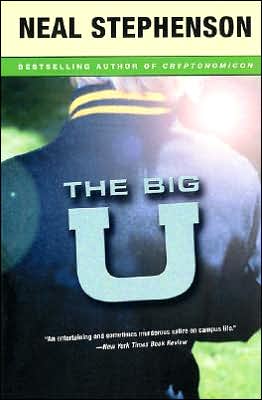
- Set in American Megaversity, a massive structure composed
of several
towers.
- Professor Redfield: Narrator. African
American associate
professor
and faculty-in-residence. Recently obtained Ph.D. in Remote
Sensing.
- The Go Big Red Fan: Not a fan of “Big
Red”, but a electric fan painted
red. Owned by John Wesley Fenrick. His roommate,
Ephrain
Klein.
- Sarah Jane Johnson: Student government president.
- Hyacinth: Sarah’s roommate and a lesbian.
- Casimir Radon: A scientist in love with Sarah.
- Fred Fine: Leader of a role-playing society.
Believes himself to
be Klystron/Chris. When open war breaks out, he becomes the
leader
of the Grand Army of Shekondar the Fearsome.
- Virgil
- Septimius Severus Krupp: President of American
Megaversity. Comes
off as a gun-loving cowboy.
- Bert Nix: An old, mentally unbalanced, and often drunk
fixture of
American
Megaversity known for babbling. Later, it is revealed that he
was
a staff member of the original campus. The experience sent
him over the edge.
- 7:
The Resident Assistant, or RA, was a
reclusive
Social
Work major who, intuitively knowing she was never going to get a job,
spent
her time locked in her little room testing perfumes and watching MTV
under
a set of headphones. She could not possibly help.
Tenuring and tenuring in the
ivory tower!
The flagron cannot fill the flagoneers.
Krupp cuts a fart! The sphinxter cannot hold
Dear academe, our Lusitania, recoils.
The time-limned dons are noosed. With airy webs
The cerebrally infarcted brings me down.
The East affects conscription, while the curst
Are gulled with Fashionate Propensities.
- 80: Casimir describes Project Spike, named after his
deceased
kitten.
He will seed rat poison near the Cafeteria with a beryllium isotope to
see if any Carbon-14 shows up in Cafeteria food.
- Steven Wilson: Killed by mutant rats in the sewer while
playing one of
Fred Fine’s live-action role playing games.
- 200: The Go Big Red Fan, known as the Little Wheel, speaks
to Dex
Fresser.
- 224:
Most people, upon listening to a
string of nonsense, will tend to
doubt
their own sanity before they realize that the person who is jabbering
at
them is really the one with the damaged brain.
The Geiger counter shouted. I looked at
Casimir.
“Skip your next chest
X-ray,” he said. “If this
place is what it looks like, it’s just Iodine-131. Half-life
of eight
days.
It’ll end up in your thyroid, which you don’t
really need anyway.”
“I’m pretty fond of
my thyroid,” said Hyacinth.
“It made me big and strong.”
- 277: Sarah is reading The Origin of
Consciousness in the
Breakdown
of the Bicameral Mind (1976) by Julian
Jaynes.
Apparently,
Stephenson mentions it in many of his novels.
FLIM-FLAM!
Psychics, ESP, Unicorns and other Delusions (1982, 5th
printing
1986)
Paperback
Prometheus Books, Buffalo, N.Y.
2003-12-20 to 2003-12-24

- 16: Sir
Arthur Conan Doyle
is hoodwinked by fairies in his book The Coming of
the Fairies
(1921)
- 21: Doyle was knighted, not for SHERLOCK
HOLMES (1887), but for his writings as a historian
defending
the
British Army in South Africa.
- 37 - 41: The Cottingly Fairies fiasco is a perfect
illustration of the
hallmarks of paranormal chicanery:
- It is claimed that the subject does not seek money or
fame, and
thus no motive to deceive exists.
- The subject (a child, peasant, or sweet little old lady)
is said
to be incapable of the techniques required; lack of sophistication
precludes
deception.
- It is said that the subject has failed to pass tests
designed to
determine if the necessary skill is present.
- Faults discovered in the story or performance tend to
prove the
phenomenon real, it is agreed, since a clever trickster would not make
such basic errors.
- If a phenomenon is consistent with previously reported
ones, this
is cited as strong evidence that it is genuine.
- It is claimed that critics give poor or insufficient
reasons for
doubting reported paranormal events and are therefore not to be taken
seriously.
- Prominent personalities lend their support to the claims
and are
considered unassailable because of prestige, academic background, and
so
on.
- Similarly, supposed experts are called in to verify the
claims.
- The findings of experts who are critical are minimized
or ignored.
- Those who allege paranormal events are equivocal and
evasive,
allowing
investigators to assume facts and fill in details in support of their
claims.
- Conflicting versions or details of a paranormal event
are ignored.
- A subject’s ability to perform trickery is
de-emphasized
or
ignored.
- Any controls that seem scientific are used to provide
authentication,
whether applicable or not.
- It is said that the subject cannot produce phenomena on
command
or on a regular basis, since such abilities are ephemeral and
sporadic.
- It is claimed that conditions that make deception
possible are
also those that allow the miracles to take place, and miracles are the
more probable explanation.
- Unless the critics can explain away all
the
reported
details,
the residue is considered an irreducible basis for validation.
- We are told that subjects do not do well when persons
with
“negative
vibrations” are nearby.
- It is claimed that when money is paid for the services
of a
psychic,
or psychic powers are used to earn money, the powers are defeated. On
the
other hand—since parapsychologists like to have it both
ways—money
rewards,
they also claim, tend to encourage performance.
- It is argued that too many controls on an experiment
cause negative
results.
- Any trickery detected by the investigators may be
attributed to
the subject’s desire to please, and therefore there is a
compulsion to
cheat.
- 42: Charles Berlitz, grandson of the famous language-book
writer,
writes
about the Bermuda Triangle.
- 44: A map demonstrates that many of the cited incidents
took place well
outside the Bermuda Triangle.
- 58: Quote from Ben Frankin:
Quacks are the greatest liars in the world, except
their patients.
- 93: A chapter on the Transcendental Meditation movement of
Maharishi
Maresh
Yogi.
- 130: One of Randi’s major criticisms of Erich von
Däniken’s
“Chariots
of the Gods” writings is that they are inherently
racist. The
ancient
residents of Africa and the Americas must have had extraterrestrial aid
in creating their wondrous ancient structures, but he offers no need
for
such creations in ancient Greece or Europe, because they would have the
intelligence to accomplish such achievements.
- Chapter 7 is on psychics and ESP.
- Chapter 8 is on biorythms.
- Chapter 9 is on psychic surgery.
- 196: Renowned physicist René Blondlot convinces
colleagues of
the
existence of “N Rays”.
- 217: The word “nincompoop” is a
corruption of the Latin non compos
= “not of sound mind”.
- 246: Lamarr Keene confessed to the IRS in 1976 that he had
bilked
thousands
of Florida residents out of their fortunes as a psychic
medium.
He
writes about it in The Psychic Mafia.
THE
SATANIC VERSES
(1988)
Hardcover
Viking, New York
2003-12-25 to 2003-12-31
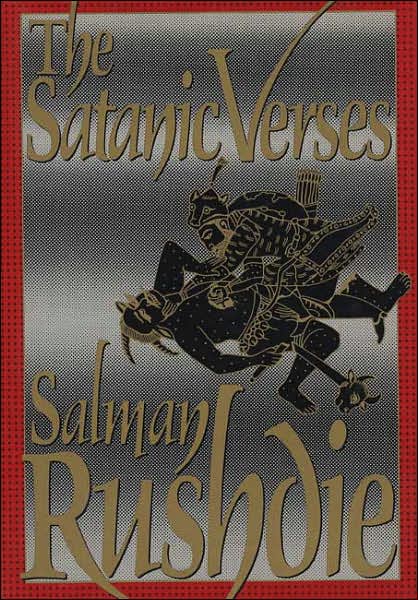
In the past ten years, nearly two
dozen people (including translators,
diplomats, and publishers, but not Mr. Rushdie) have died in defense of
this book. Several bookstores in the US and the UK have been bombed.
Over
four dozen countries have banned or restricted the novel, and Mr.
Rushdie...
well, he’s still writing, but...
- (See also IMAGINE
THERE’S NO HEAVEN (1997))
- The book opens with the two main characters, Gabreel and
Saladin,
falling
unscathed from an airplane destroyed by terrorists.
- Gabreel Farishta: After his parents died, he was taken in
by Babasahed
Mhatre. Became a Bollywood movie star. Before his
transformation,
he had notoriously bad breath.
- Saladin Chamcha (a.k.a. Salahaddin Chamchawala): Emigrated
from India
to
Great Britain. Temporarily transformed into a goat-like
creature,
and was taken in by the Sufyan family. His mother, known for
her
swank cocktail parties, choked on a fish and died. His family
home
lies on Cape Comorin, on the very tip of Asia, where three seas meet.
- Jumpy: Saladin’s leftist college buddy and
martial arts
instructor.
After believing he is dead, he moves in with Saladin’s wife
Pamela.
- Sufyan family: Their bed & breakfast overcharges
despondent
immigrants
but disregards occupancy laws.
- Alleluia Cone: She climbed Everest.
- 54:
In Zeeny’s beaten-up
Hindustan, a car built for a servant
culture, the
back seat better upholstered than the front, he felt the night closing
in on him like a crowd.
- 75 - 77: On a cruise ship, American evangelist Eugene
Dumsday lectures
Saladin on the evils of Darwinism, such as drugs and pre-marital sexual
relations. When natives of Cochin harbor offer to sell
Dumsday
drugs:
Saladin began, helplessly, to giggle.
The incident
struck
him as Darwin’s revenge: if Dumsday held poor, Victorian,
starchy
Charles
responsible for American drug culture, how delicious that he should
himself
be seen, across the globe, as representing the very ethic he battled so
fervently against. Dumsday fixed him with a look of pained reproof. It
was hard fate to be an American abroad, and not to suspect why you were
so disliked.
Question: What is the opposite of faith?
Not disbelief. Too final, certain,
closed. Itself
a kind of belief.
Doubt.
- 252 - 253: One of the not-so-subtle hints that
Saladin’s adventures are
a metaphor for immigrants in the U.K.:
Mishal Sufyan lost patience.
‘Jesus, Mum.’
‘Jesus?’
‘Dju think it’s
temporary?’ Mishal, turning her
back on scandalized Hind, inquired of Sufyan and Jumpy. ‘Some
sort of
possession
thing – could we maybe get it you know exorcized?’
Omens,
shinings,
ghoulies, nightmares on Elm Street, stood excitedly in her eyes, and
her
father, as much as the VCR aficionado as any teenager, appeared to
consider
the possibility seriously. ‘In Der Steppenwolf,’
he began, but
Jumpy
wasn’t having any more of that. ‘The central
requirement,’ he
announced,
‘is to take an ideological view of the situation.’
That silenced everyone.
‘Objectively,’ he
said, with a small
self-deprecating
smile, ‘what has happened here? A: Wrongful arrest,
intimidation,
violence.
Two: Illegal detention, unknown medical experimentation in
hospital,’ –
murmurs of assent here, as memories of intra-vaginal inspections,
Depo-Provera
scandals, unauthorized post-partum sterilizations, and, further back,
the
knowledge of Third World drug-dumping arose in every person present to
give substance to the speaker’s insinuations, –
because what you
believe
depends on what you’ve seen, – not only what is
visible, but what you
are
prepared to look in the face, – and anyhow, something had to
explain
horns
and hoofs; in those policed medical wards, anything could happen
– ‘And
thirdly,’ Jumpy continued, ‘psychological
breakdown, loss of sense of
self,
inability to cope. We’ve seen it all before.’
Only when Saladin Chamcha was alone in
the attic
room at the very end of his strength did he answer Sufyan’s
rhetorical
question. ‘I’m not your kind,’ he said
distinctly into the night.
‘You’re
not my people. I’ve spent half my life trying to get away
from you.’
- Mishal Sufyan: The underage daughter was discovered to be
involved with
Hanif Johnson, a lawyer working out of the Sufyan B&B.
- 256 - 257:
Had he not pursued his own idea of the
good,
sought to become that which he most admired, dedicated himself with a
will
bordering on obsession to the conquest of Englishness? Had he not
worked
hard, avoided trouble, striven to become new? Assiduity,
fastidiousness,
moderation, restraint, self-reliance, probity, family life: what did
these
add up to if not a moral code?
- Hal Valance: Chamcha’s agent.
- 323: A character gives us a history of Biblical exegis on
good vs. evil:
It isn’t until the Book
of Chronicles, merely fourth
century BC,
that
the word shaitan is used to mean a being, and not
only an
attribute
of God.
- Several plot paths that seem to have nothing to do with
the
main
narrative
are eventually explained: once the studios discovered that Gabreel was
alive, they took advantage of the publicity of his mysterious return
and
forced him to appear in some movies:
- A life of the prophet Mahommed, where names of people
and
places were
changed.
The title refers to words spoken by a young Prophet, allowing worship
of
pagan deities. Later, he claims that he was misled by evil
djinn,
claiming to be angels. His transcriber purposely starts
mis-quoting
the Prophet, merely to see if anyone notices. One of the
Prophet’s
young wives at first mocks his varying divine revelations, until she is
rescued from the desert by a man, and would have been put to death
without
his re-interpretation of providence. In one segment, a
brothel
attracts
clientèle by having the resident prostitutes role-play the
wives
of the prophet.
- In a modern-day indian village, a mysterious girl named
Ayesha Bibiji,
whom many believe to be a reincarnated butterfly goddess, leads the
villagers
by foot on a pilgrimage to the sea that it might part for them to walk
to Mecca. This tests the faith of the wealthy Mirza Saeed and
his
wife Mishal, who was recently diagnosed with terminal cancer.
- 353:
‘He was of the djinn,
so he transgressed.’
– Quran 18:50, there it
was
plain as the day.
 MNRay.net
MNRay.net
 MNRay.net
MNRay.net
















































